
- Salkantay Trek
- Inca Jungle Trek
- Huchuy Qosqo Trek
- Ausangate Trek
- Vilcabamba Trek
- Choquequirao Trek
- Huayna Picchu
- Altitude Sickness
- Packing List
- Humantay Lake
- Lake Titicaca
- Nazca Lines
- Rainbow Mountain
- Get A Trek Quote

Inca Trail Weather – What To Expect On The Trail
An essential part of planning your trek to Machu Picchu is taking the Inca Trail weather into consideration.
You want to give yourself the best chance of sunny days and clear skies.
To select the best time, you need to look at how Inca Trail weather patterns change over the year.
In this article, you will find information on annual rainfall, temperatures, and a month-by-month breakdown of weather on the Inca Trail.
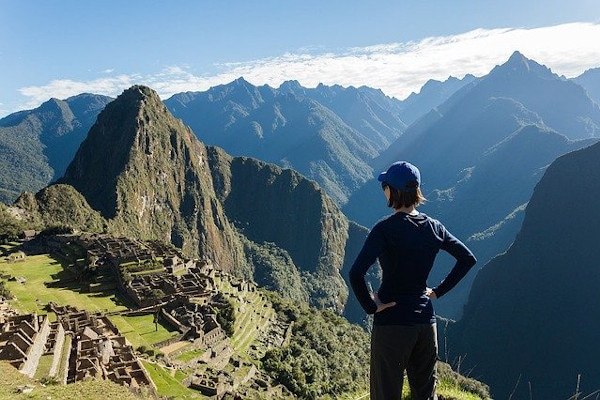
Get an Inca trail trek quote
Start planning your Machu Picchu hiking holiday.
Weather on the Inca Trail
Before planning a hike along the Inca Trail , it's best to consider all the relevant factors related to the weather and climate in Peru.
Some of these factors are overall temperatures at varying altitudes and transitions in weather conditions during the day and at night.
Weather Forecasts for the Inca Trail
When searching the weather forecast for the Inca Trail, you will not find an exact match. Your best bet is to look at the forecasts of Cusco and Aguas Calientes . This will give you a good idea of weather conditions on the trail.
Also, keep in mind that the pathway is through different habitats and changing altitudes. On a single day of hiking, you can go from hot and humid jungles to icy cold mountain passes.
Looking for a day tour? Here are my 5 favourite day tours around Cusco:
- Rainbow Mountain day trip (with meals)
- Moray and Salt Mines Quad Bike Tour
- Sacred Valley day tour
- Humantay Lake day tour
- Machu Picchu and Huayna Picchu entrance tickets
See more Cusco day trips .
Luckily for your planning, there is a clear dry and wet season on the Inca trail. We will talk about this in more detail in our article on the best time to hike the Inca Trail .
There are also many different microclimates to factor in. It is impossible to get a weather prediction that is 100% accurate. You may experience clear and sunny days hiking in December or get caught in the rain in July.
Fast Tip: Bring wet weather gear no matter when your hike is planned.
Rainfall On the Inca Trail
The wet season in the Cusco or Aguas Calientes region is between November and March.
If you can, it is best to avoid hiking the Inca Trail over this time. December, January, and February are the wettest months. In fact, the Classic Inca Trail and Salkantay/Inca Trail Combo are closed for maintenance in February.
In winter, (May-September) the days are cool with a low chance of precipitation. This makes May-September a great time to hike the Inca trail.
The chart below shows the average monthly rainfall for the Inca trail:
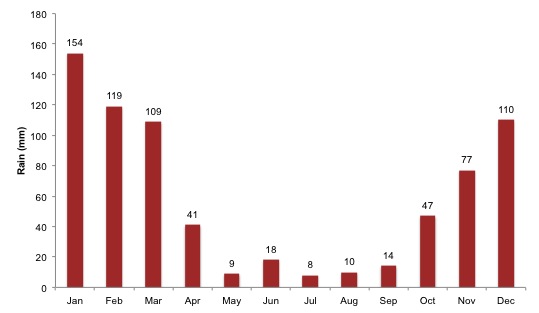
Please Note: It is possible to trek the Short Inca Trail or any of the alternative treks to Machu Picchu during February.
Temperatures On the Inca Trail
Temperatures in the region are fairly consistent throughout the year. Days reach into higher temperatures of 20 degrees Celsius (70-80 degrees Fahrenheit) and drop into the low digits. Campsites on mountain passes are especially cold. You may experience sub-zero temperatures at night and in the early mornings.
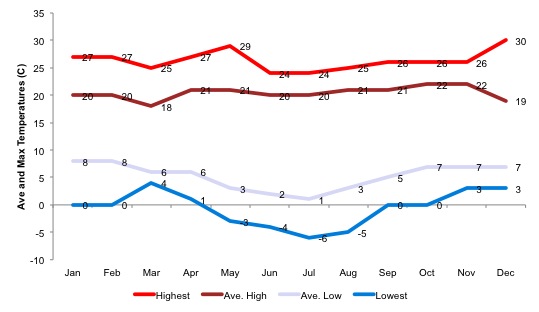
Temperature fluctuations are common as you ascend high passes or drop into sun-exposed valleys. During the evenings, temperatures regularly hover around the zero- degree Celsius mark.
Fast Tip: It is important that you take layered clothing to adjust comfort levels as temperatures fluctuate throughout the day. You will find that you strip off or add layers as you cross different levels of altitude. See our full Inca trail equipment list .
Inca Trail Weather by Month
The tables below give average temperatures, rainfall, and hiking conditions for each month.
Please Note: This is only a guideline based on historic climate patterns. There's no way to guarantee ideal hiking conditions.
Inca Trail Weather in January
Inca trail weather in february, inca trail weather in march, inca trail weather in april, inca trail weather in may, inca trail weather in june, inca trail weather in july, inca trail weather in august, inca trail weather in september, inca trail weather in october, inca trail weather in november, inca trail weather in december.
Alison Macallister
With a degree in Nature Conservation and experience working with wildlife including the Big 5, Alison works as a guide for a 5-star reserve. She enjoys sharing her passion for all things nature-related. She enjoys hiking, horseriding, 4x4 driving and kayaking.
Leave a Reply
Your email address will not be published. Required fields are marked
Name * * * *
Email * * * *
Get a quote from our recommended local trek operator in Peru
Get a Machu Picchu trek quote
Best Local Guides. Great Value Hikes.
- Just Me
- Me + 1
- Me + 2
- Me + 3
- Me + 4
- Me + 5
- More than 6
Quick Steps to Book the Inca Trail
- Pick your preferred Inca Trail Tour!
- Check availability!!
- Choose a recognized agency!
- Pick a payment method.
- Pay and Book the Inca Trail
- Sort out your flight to Peru!
- Book a hotel in Cusco.
- Get in Form and start packing!
6 Tips to hike the Inca Trail to Machu Picchu
How to tackle the best hike in the world like a pro.
DOWNLOAD NOW FOR FREE
no spam / no payments

Inca Trail Weather
Generally speaking, the Inca Trail weather varies along the length of the trek and can be pretty unpredictable and difficult to foresee. The Inca trail weather does not only depend on the month of the year, but it also varies as you pass through different microclimates. In other words, the Inca Trail weather can change from day to day and from location to location. You better prepare for variable circumstances.
Inca Trail weather: day by day
During the Inca trail Peru you can experience cold, sun, hot, dry and wet moments. Usually, the days are usually bright and sunny. If rain falls, often the temperature will drop, and it can feel colder. During the nights, it can be quite cold.
The first two days, it will most likely be drier, and it can be more humid on the third and fourth days of the Inca Trail Peru. During the nights, the first two campsites are often cold, while the third night is more temperate.

Inca Trail: the rainy season
Although rain can make the hike a little more difficult and the Inca Trail is less popular in the rainy season, on the other hand, the landscapes benefit from the rain and are green and lush. Also, the trail will be less crowded.
Please note that the Inca Trail is closed in February , partly due to heavy rains that can cause erosion but also for maintenance and clean up.
Best time for the Inca Trail
We can say that the months between April and November are considered the best time for the Inca trail. Note that especially the nights are colder between half of May and half of July. January and March are the wettest months.
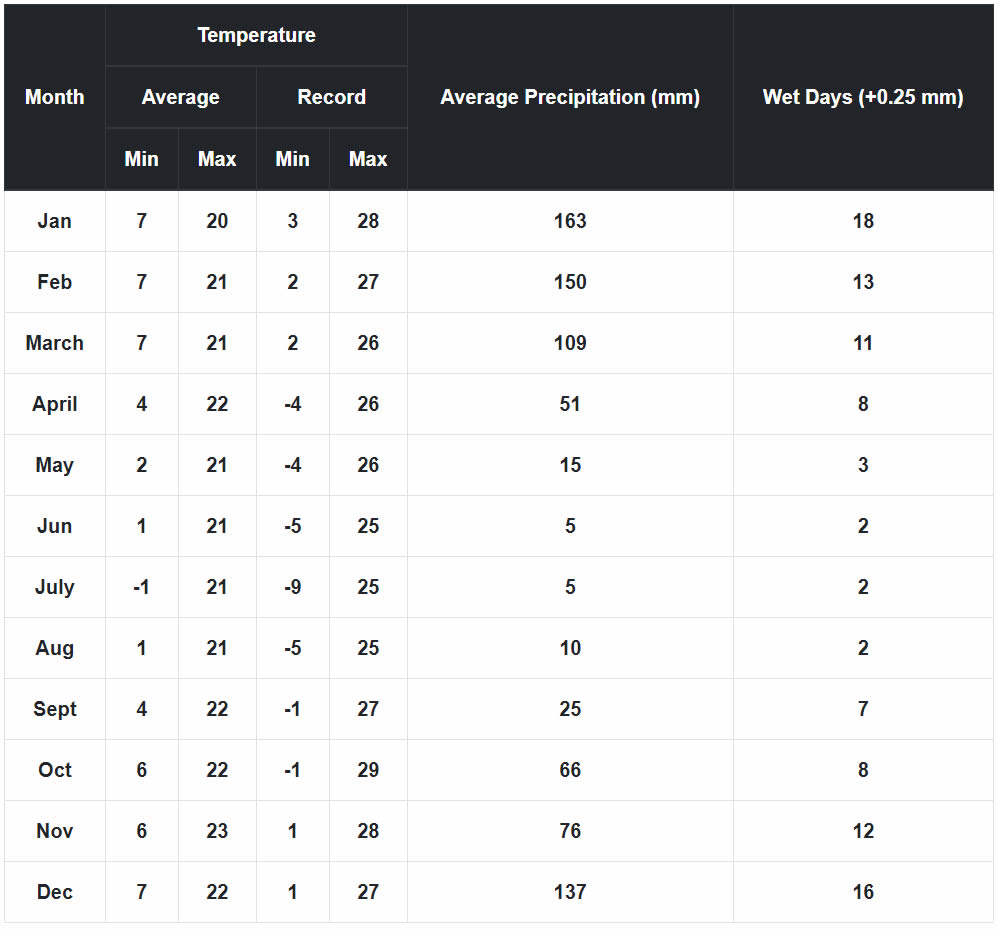
Quicks Links to:
- Salkantay Backpackers
- Inca Jungle Trek
- Ausangate Trek
- Choquequirao Trek
- Huchuy Qosqo
- Sacred Valley
- Cusco Practical Information
- Cusco Health and Safety
- Cusco Faq's
- Cusco Tours
- Salkantay Mountain
- Machu Picchu
- Ollantaytambo
- Colca Canyon
- Lake Titicaca
- Sacred Valley of the Incas
- Amazon Rainforest
- Nazca Lines
- Choquequirao
- Walking & Trekking Tours
- Short Hikes & Tours
- Cultural Discovery
- Family Holidays
- Pristine Rainforest
- Multi-Adventure Tours
- Peru Travel Packages
- Luxury Holidays Tours
- Inca Trail Alternative Treks
- Tickets, Tours & Guide 2024
- San Martin School
- Reusable snack bags
- Reforestation with Native Trees
- Essentials Peru
- The best time to visit Peru
- What to bring on a Hike
- Things to do in Peru
- Getting to Machu Picchu
- Inca Trail Trek & Tours FAQs
- Camping Equipment
- How to Book & Payment
- Booking terms & conditions
- Coronavirus Travel Policy
Inca Trail weather: What is the best month to hike the Inca Trail?
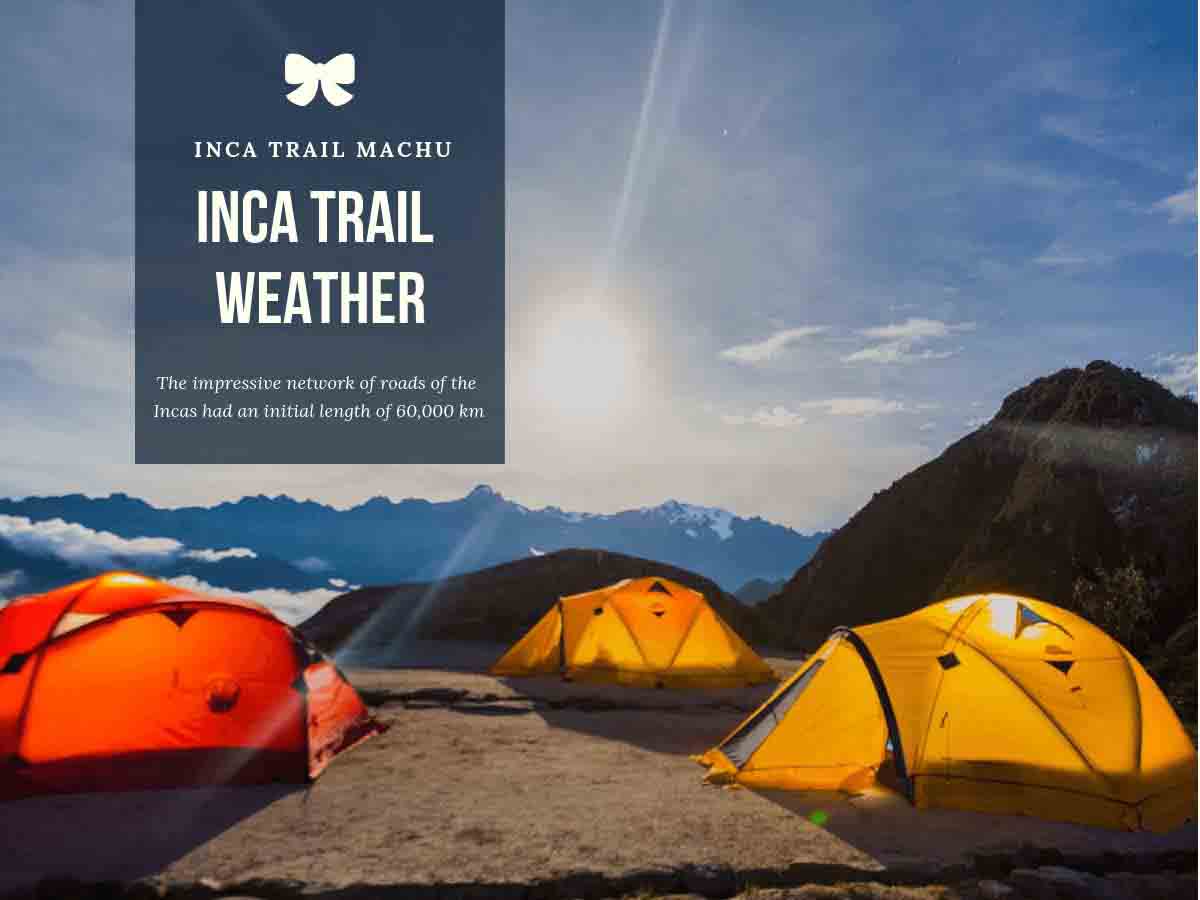
There are thousands of kilometers of " Caminos del Inca " in all of Peru; however, we focus on the 4-day Classic Inca Trail, which begins at km 82 via ferrea to Machu Picchu .
It is a route in which varied ecosystems unite with a sequence of monuments of the finest Inca architecture, ending in the classic postcard view of Machu Picchu observed from above. That is why this road was designed, a route of pilgrimage and purification to access the sacred llacha of Pachacútec; they are 35 kilometers that run through the valley of the Cusichaca River, the Abra de Warmihuañusca, the Pacaymayo ravine, passes through the Inca Trail ruins of Sayacmarca, Phuyupatamarca, Wiñayhuayna; On the way you can see tunnels dug in live rock.
During the Inca Trail , you will pass through different altitudinal floors, from 2,400 m. up to 4,200 m., at the highest point and of course, this influences the climate, which varies according to the height of the place you are visiting.
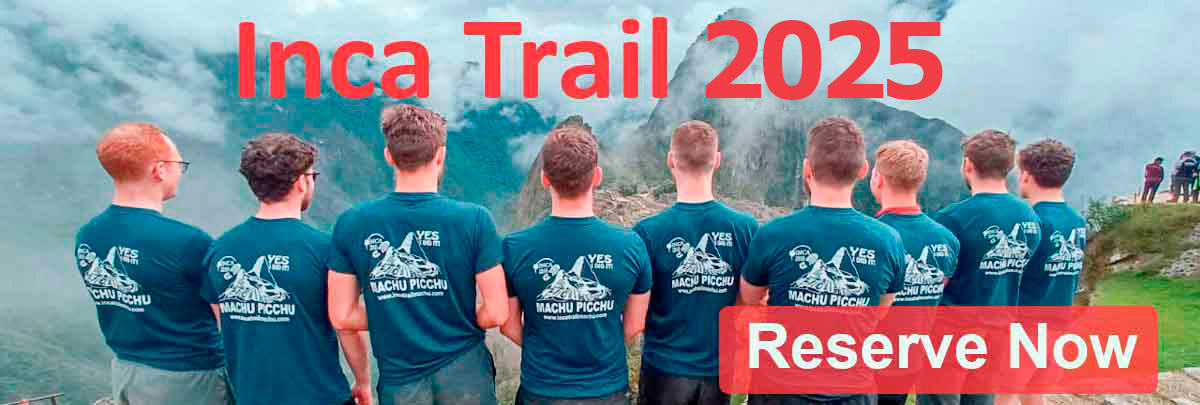
It should be noted that there are two types of Inca Trails:
The first one is the Inca Trail 4 Day s that begins in Piscakucho (2,800 m.) And the highest point is Warmiwañusca - Paso de la Mujer muerta (4,200 m.), During this hike, we will go through different ecological floors, with climatic variations from cold to warm.
The second one is the 2-day Inca Trail begins in Chachabamba (2,250 m.) And the highest point is the Intipunku (2,750 m.). During the walk, the climate is warm in the dry season and at the time of cloudy and warm rain, obviously with the presence of rain.
It should be noted that in the month of February, it is impossible to reserve the Inca Trail, given that the Ministry of Culture closes the road during this month, to maintain and improve the route.
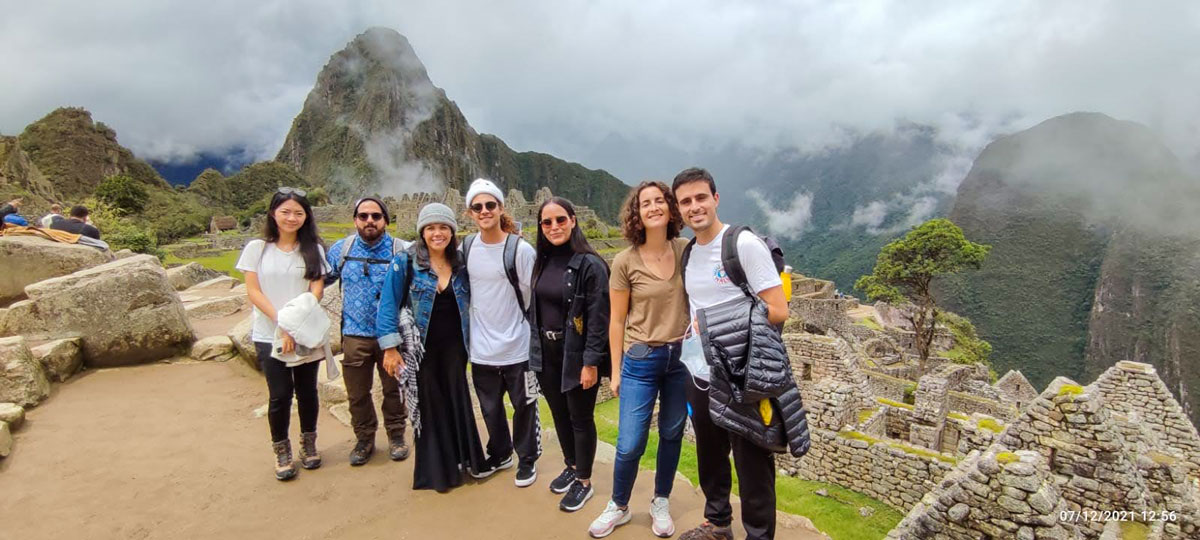
Inca Trail weather
The Inca Trail weather varies according to the months some with presence of rains, sunny days, cloudy days, cold nights; then we detail the Inca Trail weather per month:
- In the months of January and March the rains are persistent mostly at night, the days are cloudy but there are nice and sunny days, if we have good luck.
- In the month of April, the rainy season ends little by little, and the days become warmer and more pleasant, with sporadic rains.
- Between May and October, the climate is warm and cool, with little rain, sunny days and quite bright.
- The months of June, July, August and September are undoubtedly the best months to complete the Inca Trail, during the day it is clear and you can clearly observe the landscapes, the days are fresher, however, the nights are cold in the high areas.
- During November and December, it is the time when the rainy season begins, the days are sunny, but at any moment it can rain, as well as, there are cloudy days without rain.
The current weather in the Inca Trail Peru can also be found at: Inca Trail weather by month
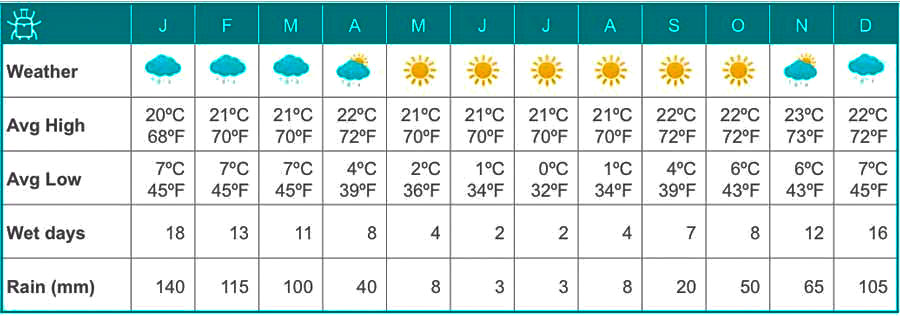
RELATED: MACHU PICCHU WEATHER BY MONTH
Best Month For Inca Trail : Overview
Temperatures.
The average annual temperature is 12 °C. The warmest month is December (13.7 °C), and the coldest month is July with an average of 9.7 °C.
Precipitation
The annual precipitation is 736 mm on 105 days. January and February are rainy seasons, i.e. months with more than 175 mm of precipitation. Snowfall is possible in the months of May, June, July, August and September.
According to our climate table, July is the sunniest month with an average of 8.3 hours of sunshine per day. The sun shines an average of 6.4 hours a day over the year.
Cities nearby
Larger cities with a similar climate are close to Cusco Peru .
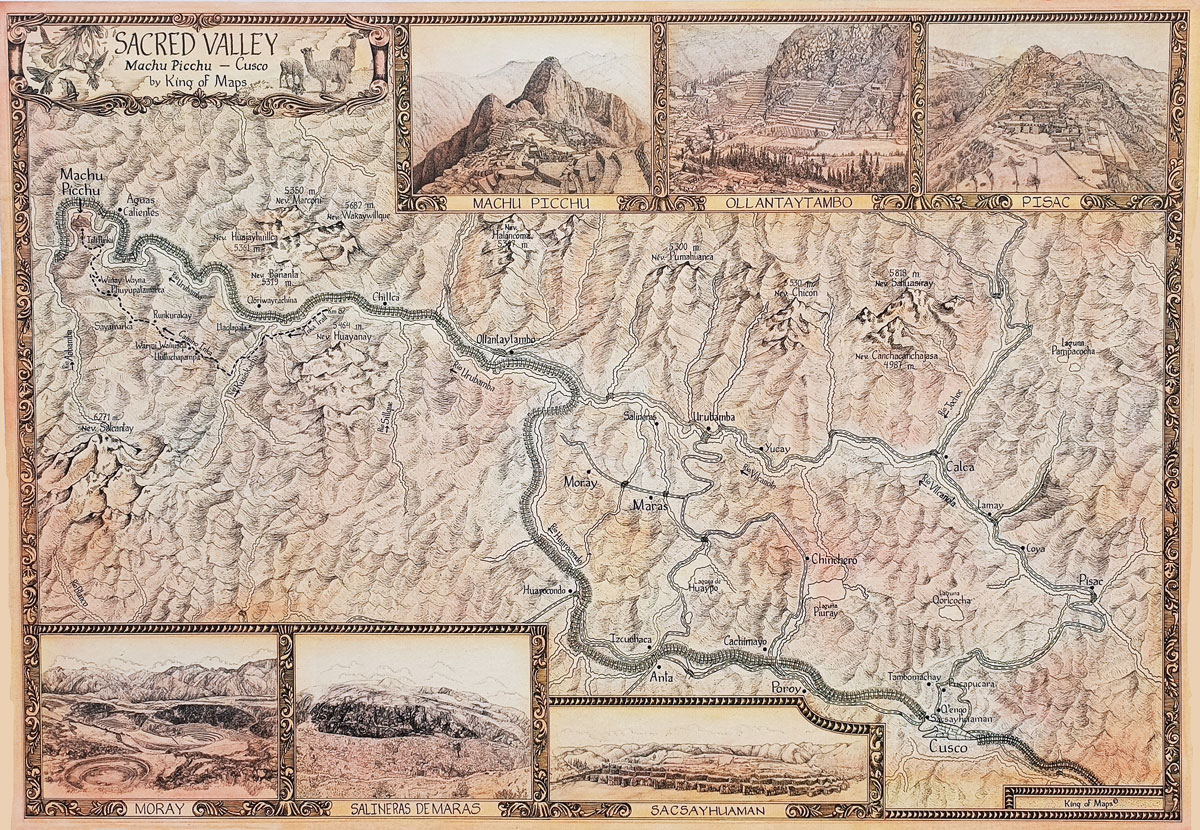
What is the best time to go to the Inca Trail?
On the Royal Inca Trail , there are two distinct periods, the dry season and the rainy season. The best time to travel the Inca Trail is from April to October (dry season), the months of November to March, is the rainy season, which makes it difficult, the accesses and camps.
The maximum temperature is 19ºC and the minimum temperature is 0ºC. The relative humidity of the air ranges between 77% in the dry season and 91% in the rainy season. The annual rainfall ranges from 1,571 to 2,381 millimeters.
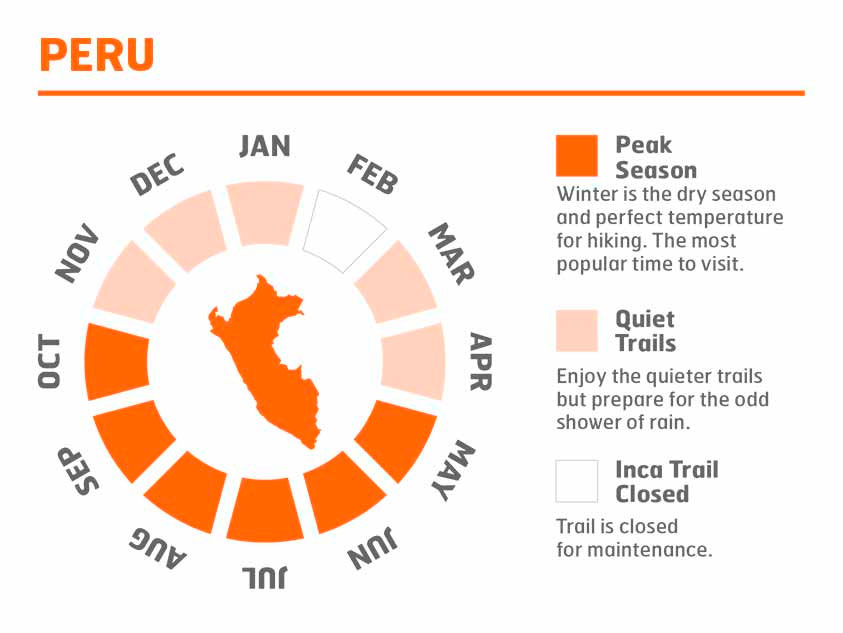
The Best Inca Trail
- 2 Day Inca Trail with camping
- 3 Day Inca Trail
- Inca Trail trek (9 days/ 8 nights)
- Peru Treks & Adventure (18 days/ 17 nights)
If the Inca Trail is sold out, don´t worry, we recommend you take the alternative treks to Machu Picchu or you can take the Machu Picchu tours by train, in these services are included the Machu Picchu tickets early.


- [email protected]
- +51 984 315 337
- + 51 972 390 728
- Machu Picchu Circuits
- 6 Day Inca Trail via Salkantay Trek
- 5 Day Inca Trail to Machupicchu(Unique)
- 4 Day Classic Inca Trail to Machupicchu (GROUP SERVICE)
- 4 Day Classic Inca Trail to Machupicchu (PRIVATE SERVICE)
- 3 Day Inca Trail (Challenge) KM 82
- 3 Day Inca Trail (New) KM 104
- 2 Day Inca Trail (Short) KM 104 With Hotel
- 2 Day Inca Trail (Short) KM 104 With Camping
- 1 Day Short Inca Trail to Machupicchu Km 104
Salkantay Peru Treks
- 5 Day Salkantay Sky Lodge Dome (GROUP)
- 4 Day Short Salkantay Sky Lodge Dome (GROUP)
- 5 Day Salkantay Sky Lodge Dome (PRIVATE)
- 4 Day Short Salkantay Sky Lodge Dome (PRIVATE)
- 5 Day Salkantay Trek Camping (GROUP)
- 4 Day Salkantay Trek Camping (GROUP)
- 3 Day Salkantay Trek Challenge + Sky Lodge Dome
Salkantay Trek Packages
- 9 Day Salkantay Sky Lodge Dome + Tambopata Amazon
- 9 Day Salkantay Sky Lodge Dome + Rainbow Mountain
- 8 Day Salkantay Sky Lodge Dome + Cusco
- 6 Day Salkantay Sky Lodge dome + Short Inca Trail
- 4 Day Salkantay Sky Lodge Dome + Short Inca Trail
- 3 Day Salkantay Sky Lodge Dome + Machu Picchu by Train
- 2 Day Humantay & Salkantay Trek + Sky Lodge Dome
- 1 Day Humantay Lake
Luxury Salkantay Treks
- 4 Day Luxury Salkantay + Sky Lodge Dome
Machupicchu Tours
- 2 Day Rainbow Mountain to Machupicchu
- 2 Day Humantay Lake Tour to Machupicchu
- 2 Day Sacred Valley with Machupicchu
- 2 Day Quad Biking Maras Moray to Machupicchu
- 2 Day Cusco Maras Moray hike to Machupicchu
- 2 Day Machu Picchu by Bus
- 2 Day Inca Trail Via Llactapata Trek (new)
- 2 Day Horseback Maras Moray to Machupicchu
- 2 Day Biking Maras Moray to Machupicchu
- Choquequirao Treks
- 12 Day Choquequirao – Salkantay – Inca Trail (Unique)
- 9 Day Choquequirao to Machupicchu
- 5 Day Choquequirao Trek to Machupicchu
- 4 Day Choquequirao Trek 4D/3N(Classic)
- 3 Day Choquequirao Trek (Challenge)
Ausangate Treks
- 6 Day Ausangate Machupicchu Trek
- 4 Day Ausangate Trek (Classic)
- 3 Day Rainbow Mountain to Machupicchu
- 2 Day Rainbow Mountain Trek
Luxury Glamping Peru Treks
- 4 Day Inca Trail Glaming Dome to Dome (Luxury Service)
- 4 Day Salkantay Trek Glamping Dome to Dome (Luxury Service)
- 4 Day Lares Machupicchu Trek Glamping Dome to Dome (Luxury Service)
- 5 Day Choquequirao Machupicchu Trek Glamping Dome to Dome (Luxury Service)
Other Tours
- 2 Day Nazca Lines from Lima
- 1 Day Nazca Lines
- 2 Day Colca canyon
- 2 Day Titicaca Lake
- 1 Day Cusco Puno Bus Service
Inca Jungle Trails
- 4 Day Inca Jungle Trail (Premium) + Sky Lodge Dome (Top Selling)
- 4 Day Inca Jungle Trail (Classic) + Sky Lodge Dome
- 3 Day Inca Jungle Trail (Short) + Sky Lodge Dome (Top-Selling)
- Lares Treks
- 4 Day Lares Trek to Machupicchu
- 4 Day Lares Trek and Inca Trail (new)
Other Top Treks
- 4 Day Socma Inca Quarry Treks
- 3 Day Huchuy Qosqo Trek to Machupicchu
- 5 Day Socma Ancascocha Trek
- 6 Day Vilcabamba to Machupicchu
Peru Travel Short Packages
- 4 Day Cusco Machupicchu ( Top-Selling )
- 5 Day Salkantay & Rainbow Mountain Trek Glamping Sky Lodge Dome
- 5 Day Cusco rainbow mountain Mapi ( Top-Selling )
- 5 Day Cusco Short Inca Trail Package
- 6 Day Cusco – Titicaca Package (Classic)
- 7 Day Machupicchu & Amazon Tambopata ( Top-Selling )
- 7 Day Cusco Inca Trail Package ( Top-Selling )
- 8 Day Salkantay Trek & Amazon Tambopata Package
- 8 Day Cusco Rainbow Mountain Salkantay Trek Package
- 8 Day Inca Trail & Manu Jungle Tour Package
- 8 Day Lima Cusco Classic Inca Trail Package
- 9 Day Lima Cusco MachupicchuTiticaca Package (Classic)
- 9-Day Inca Trail & Inti Raymi Festival Tour
Peru Travel Large Packages
- 9 Day Short Inca Trail Peru Package
- 9 Day Inca Trail Amazon Rainforest Tambopata ( Top-Selling )
- 9 Day Inca Trail & Tambopata Jungle Package ( Top-Selling )
- 10 Day Inca Trail – Lima – Nazca Package
- 11 Day Inca Trail Peru Package ( Top-Selling )
- 12 Day Lima Nazca Colca Canyon Titicaca Machupicchu
- 13 Day Lima Cusco Amazon Jungle Inca Trail Titicaca Package ( Top-Selling )
- 14 Day Lima Cusco Inca Trail Nazca Sport Package
- 15 Day Lima Cusco Amazon Jungle Titicaca Colca Canyon Package
- 16 Day Lima Cusco Inca Trail Tambopata Amazon Titicaca Colca Canyon
- 17 Day Lima Cusco Rainbow Mountain Mapi Manu Reserved Zone Colca Canyon ( Top-Selling )
- 17 Day Peru Travel Package ( Top-Selling )
- 20 Day Peru Overland Tour Package
Manu Reserved Zone Tours
- 8 Day Manu Reserved Zone
- 6 Day Manu Biosphere Reserved Zone
- 5 Day Manu Jungle Trip (Expedition)
- 4 Day Manu Jungle Tour Holiday
- 3 Day Manu Jungle Holiday
Tambopata Jungle Tours
- 5 Day Upper Tambopata Chuncho Macaw Clay Lick and Sandoval Lake
- 4 Day Upper Tambopata Chuncho Macaw Clay Lick and Sandoval Lake
- 2 Day Upper Tambopata Chuncho Macaw Clay Lick
- 4 Day Amazon Jungle Tour Tambopata Sandoval Lake & Monkey Island (from Cusco)
- 4 Day Tambopata Jungle Trip
- 3 Day Tambopata Sandoval Lake and Monkey Island
- 2 Day Tambopata Sandoval Lake and Monkey Island
- 1 Day Tambopata Sandoval Lake and Monkey Island
- 1 Day Tambopata Zip Lining Canopy Kayak to Monkey Island
- 1 Day Rainbow Mountain Tour
- 1 Day Humantay Lake Tours
- 1 Day Machupicchu Tour by Train
- 1 Day Quad Biking Atv Maras Moray – Quad Biking Cusco
- 1 Day Sacred Valley of the Inkas – Sacred Valley Tour
- 1 Day Cusco City Tour – Cusco Tours
- 1 Day Mountain Biking Maras Moray
- 1 Day Peru River Rafting Upper Urubamba
- 1 Day Mountain Hiking Maras Moray
- 1 Day Cusco Peru Paragliding – Peru Paragling
- 1 Day Horseback Riding Maras Moray
- 1 Day Llama Trekking Maras Moray – Llama Hike Peru
- 1 Day Kayaking Huapo Lake – Kayak Peru
- 1 Day Cusco Zip Lining
- 11 Day Glamping Cusco Salkantay Humantay Amazon Tambopata National Reserve
- 11 Day Glamping Salkantay Trekking and Amazon Tambopata National Reserve
- 7 Day Glamping Cusco Salkantay Trekking to Machu Picchu
- 7 Day Glamping Cusco Salkantay Humantay to Machu Picchu
Inca Trail Weather: Best Times to Embark on Your Trek
The Inca Trail is a mesmerizing journey through history and nature. However, weather greatly influences its beauty . Choosing the right season can make all the difference.
Weather conditions vary significantly throughout the year. Some months offer clear skies and mild temperatures. Others might surprise trekkers with heavy rainfall or chilling winds.
A memorable trek requires preparation and timing. Knowledge about the trail’s climatic patterns is crucial. Let’s delve into the best times to embark on this iconic adventure.
Understanding Inca Trail Weather Patterns
Inca Trail weather is a pivotal aspect of the trekking experience. The Andes Mountains influence the region’s climate significantly. The trail experiences two distinct seasons: wet and dry.
From November to March, it’s the rainy season. The Inca Trail experiences frequent downpours during this period. This can make the trek slippery and challenging.
Conversely, April to October is the dry season. It’s the best time to trek the Inca Trail . Skies are often clear, and temperatures are moderate.
However, it’s worth noting a few nuances. The nights can get quite chilly, even during the dry months. We always recommend travelers to pack layers.
The Inca Trail weather also varies by altitude. As you ascend, temperatures generally drop. You can feel this profoundly, especially at night.
Many tourists aim for May and June. These months strike a balance between dry conditions and fewer crowds. Thus, offering an optimal trekking experience.
However, those keen on the Short Inca Trail may have a different bucket list. The bucket list for the Short Inca Trail might lean towards the shoulder months. This means slightly before or after the peak dry season.
Regardless of when you choose to go, always be prepared . Inca Trail weather can be unpredictable at times. Carrying waterproof gear and good footwear is paramount.
Understanding the Inca Trail weather patterns aids in planning. It ensures that trekkers have the best possible experience. After all, nature’s mood greatly impacts this iconic journey.

The ideal seasons for Inca Trail Adventures
Inca Trail weather plays a fundamental role in planning your adventure. This ancient route offers varying climates throughout the year. Hence, picking the ideal season is crucial.
April to October marks the dry season. Many deem this the best time to trek the Inca Trail . The weather remains favorable with less rainfall.
During these months, the trail witnesses clearer skies. Nights are cooler, but days are pleasantly warm. This combination ensures a comfortable hike.
or those aiming at Machu Picchu, timing matters. The best time to hike and climb Machu Picchu is during this period. The ruins stand majestically against a backdrop of sunny skies.
Yet, the dry season also attracts more tourists. So, expect a bustling atmosphere on the trail. We recommend booking early to secure spots.
The rainy season runs from November to March. Inca Trail weather becomes more unpredictable then. Wet paths can pose challenges for inexperienced hikers.
However, the landscape comes alive during rains. Greenery envelops the mountains, offering picturesque views. The trade-off? A slightly tougher trek.
Despite the rains, many still embark on this journey. Fewer tourists mean a more serene experience. And the rain adds a touch of mystique to the ruins.
When planning, always check Inca Trail weather forecasts. Being prepared for weather changes is essential. Remember, mountain climates can shift rapidly.
Hiking the Inca Trail has multiple facets. Each season presents its unique charm and challenges. The choice lies in your preference and readiness.

Planning your journey: Weather considerations and recommendations
When planning an Inca Trail to Machu Picchu journey, weather is paramount. The Andes offer varied climates throughout the year. Each month presents unique trekking conditions.
Firstly, understand the two main seasons. The dry season runs from April to October. Days are warmer, and skies are clearer.
This period attracts most trekkers. But remember, it can also be the busiest. Ensure you book your spot early.
The rainy season spans November to March. Rainfall is frequent, and trails can be slippery. However, it brings lush landscapes to life.
These weather patterns influence packing. For the dry months, lightweight clothing suffices. Yet, always bring layers for cooler evenings.
In the rainy season, waterproof gear is a must. This includes rain jackets and water-resistant footwear. Don’t forget to pack insect repellent too.
Altitude can influence weather as well. As you ascend, temperatures tend to drop. Preparing for colder climates is crucial, even during warmer months.
Hydration is essential regardless of the season. The high altitude can cause dehydration faster. Carry sufficient water and stay refreshed.
Lastly, always prioritize safety. If unfamiliar with mountain treks, consider hiring a guide. Their experience can be invaluable in unpredictable weather.
Weather greatly impacts the Inca experience. Proper preparation ensures a memorable and safe journey. And if you’re ready to embark, consider two exceptional options. Take a Classic Inca Trail for an iconic experience.
Or, for the more adventurous, a Choquequirao Trek awaits. Both promise unforgettable memories and breathtaking views.

OUR REWARDS IN TRIPADVISOR
QUECHUAS EXPEDITIONS GLAMPING SPECIALIST – HIGHLY RECOMMENDED ON
The Best Local Direct Tour Operator 100% Cusco Based Company. Trekking & Jungle Expeditions Tour Operator Specialists
Large – Small – Private – Glamping Luxury Tours
We Support Sustainable, Responsible & Ethical Tourism…

Eco Friendly

Animal Welfare

Sustainable Tourism

Best Choice

100% Guarantee

What Makes us Different?

Machu Picchu rules 2020
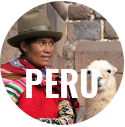
100% Local Tour Operator

Porter Welfare

Our Partners

Contact Information
- Cusco Office Address: Pasaje Pumacchupan #196. Urb: CENTRO HISTORICO
- [email protected]
- [email protected]
- [email protected] (Travel Companies Only)
- +51 - 984 315 337
- +51 - 972 390 728
Usefull Links
- Inca Trail Availability
- Payments Methods
- Terms & Conditions
- Social Projects
- Our Certifications
- Machu Picchu new Regulations
- Our Satellite Phones
- Our Quechuas Private Lodges
- NEW Machu Picchu Circuits
Destinations
- Salkantay Treks
- Inca Trail Treks
- Inca Jungle Peru
- Tambopata Amazon Rainforest
- Manu National Park
- Ausangate treks
- Huchuy Qosqo Treks
- Rainbow Mountain
- Humantay Lake
About Quechuas Expeditions
Quechuas Expeditions is a tour operator with more than 14 years of experience in the service and quality of attention to all our travelers; we are direct operators in all our routes; that is why we will always be with you.
We are a company committed with our workers, our environment and the commitment with our community; we offer responsible trips all over Peru; with us you can personalize your trip.
® Quechuas Expeditions. 2000 - 2024 All Right Reserved.
SEO by Digixonic Studios
Lists by Lukiih 🍀
Practical travel guides with less fluff
☀️ Inca Trail Hike Practical Guide: Risks & Firsthand Tips
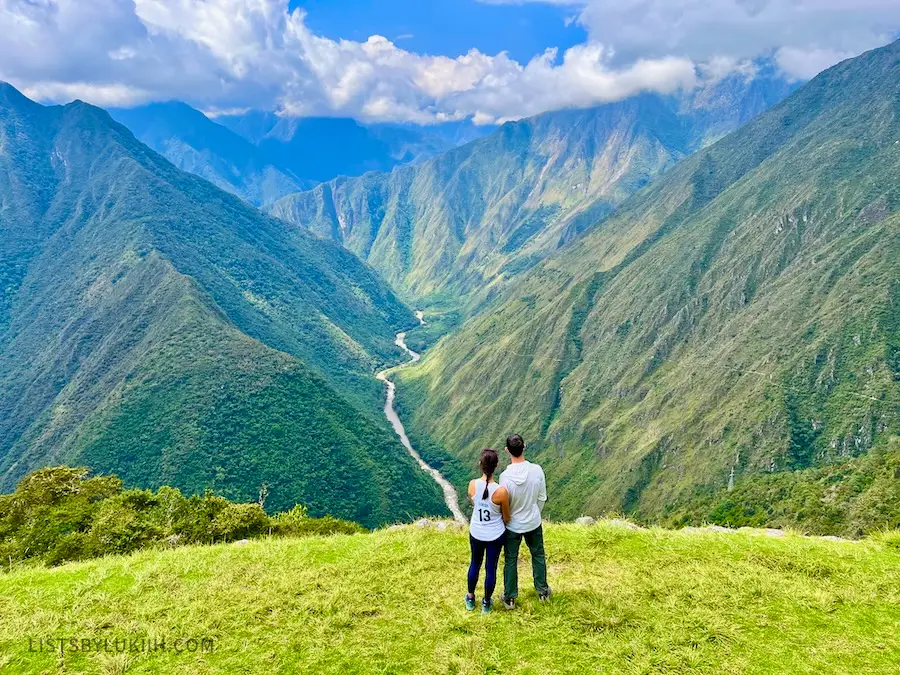
Passing through cloud forests, ancient ruins, and breathtaking views, the iconic four-day Inca Trail hike to Machu Picchu is a bucket list experience for many.
Hiking the Inca Trail is one of my most unforgettable experiences in Peru, and here, I share practical tips on preparing for the trek. This post covers:
- 💡 Hike difficulty, length, and cost
- 🚽 How to prepare & what to expect
- 🎒 What to pack for the trek
- 💥 Risks & bad scenarios
- 💰 Inca Trail tipping etiquette
Planning a trip? Here’s what to know about Peru .
Inca Trail Overview
- Is It Worth It?
- Tipping Guide
- Altitude Sickness
- Physical Inability
- Getting Sick
- Peru Protests
- Bad Weather
- What to Pack
Peru Trip Planner
Lists By Lukiih is readers-supported. When you buy with my affiliate link, I may earn a small commission. Thanks!
Before getting into safety tips and what to pack, here is some general information on the Inca Trail to help you plan your trip.
⛰️ What Is the Inca Trail?
The Inca Trail is a multi-day trek that ends at Machu Picchu , the site of the most famous Inca ruins and one of the Seven Wonders of the World.
The trek is known for its scenic beauty and challenging mountain passes .
The Inca Trail is believed to have been the same route the Incas took back in the 15th century.
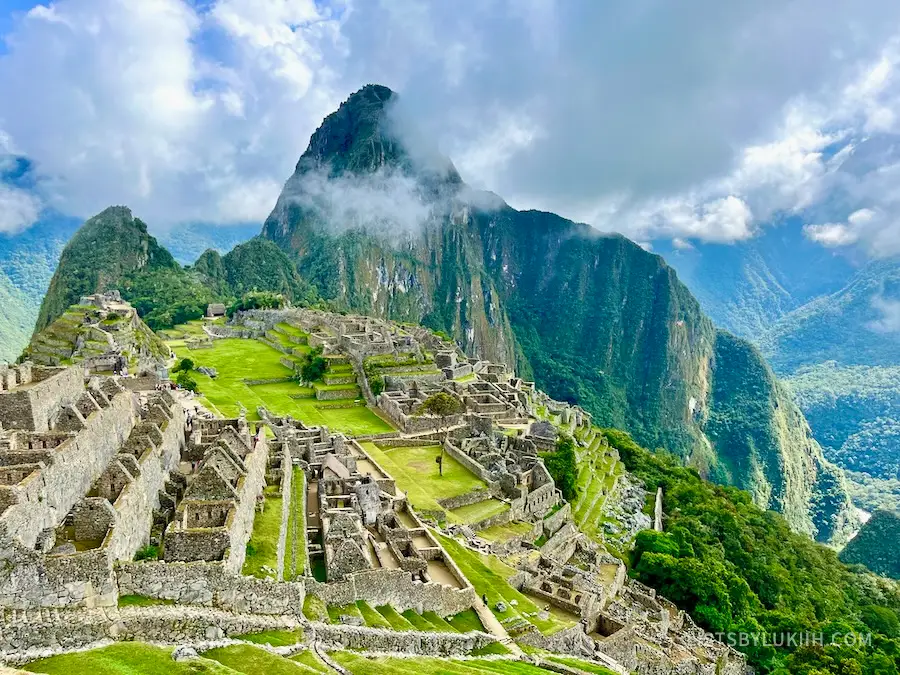
🗓️ How Long Is the Inca Trail?
The classic Inca Trail route covers 26 miles and takes four days . It’s the most popular route with ~200 tourists hiking it each day.
The Peruvian government sets a limit on the number of Inca Trail hikers per day to slow erosion.
There are three other less popular routes to Machu Picchu with varying durations:
🥾 2-Day Inca Trail Route
The two-day trek does the latter segment of the classic route and is considered easy to moderate . It’s a good option for those who have limited time or are not in the physical shape to do the classic trek.
🥾 5-Day Inca Trail Route
The five-day trek takes the same route as the classic route, but stops and camps at Llactapata, a bonus Inca site. This route is considered a moderate hike.
Since it’s not as popular, you will likely have to book a private tour to do the five-day Inca Trail trek.
🥾 Salkantay Trek
The Salkantay trail is a six-day difficult trek with spectacular mountain sceneries. This route adds 20 miles and has a higher elevation than the classic trek.
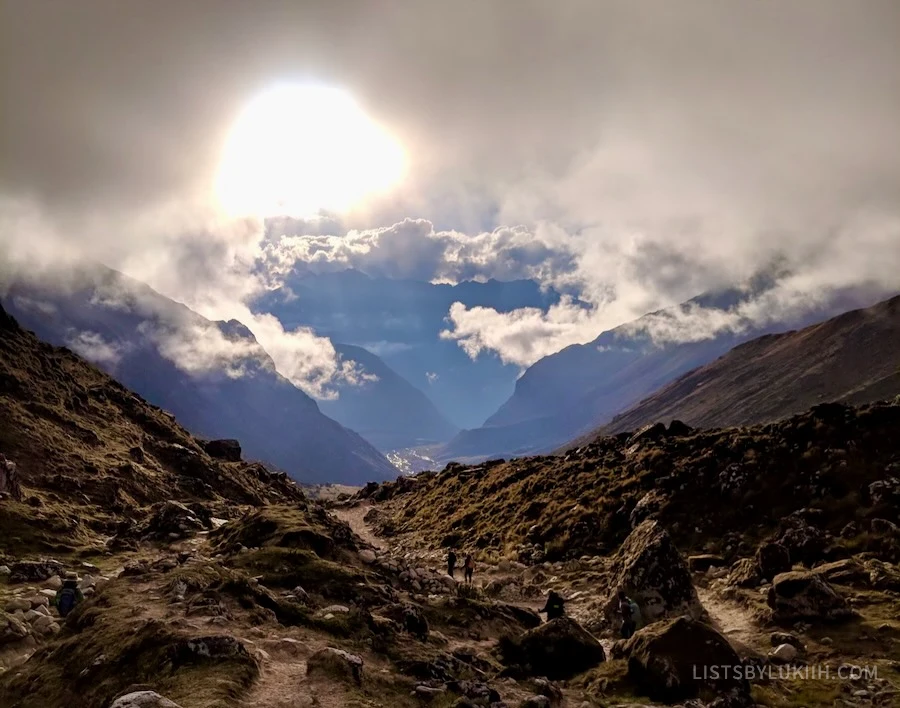
In this post, I will give tips and write about my experience with the classic Inca Trail trek.
💪🏻 Is the Inca Trail Hard?
The Inca Trail is considered a moderate to challenging hike and requires a reasonable level of physical fitness to complete. It’s a hard hike for several reasons:
- High altitude – The Inca Trail reaches a maximum altitude of 13,828 feet. Almost everyone, regardless of their level of fitness, will likely experience fatigue or a headache at some point.
About 50% of people not accustomed to high altitude will have some altitude sickness symptoms starting at 10,000 feet of elevation .
- Steep – You’ll be hiking steep ascents and descents for several hours each day.
- Long – The trail is 26 miles long and takes four days to complete, so you’re hiking more than six miles each day at high altitude.
Here’s what you can generally expect each day on the Inca Trail:
For another activity that requires less fitness, consider visiting Huacachina .

🥾 Can You Hike the Inca Trail Without a Guide?
Every trekker requires a permit to hike the Inca Trail. Since tour operators apply for Inca Trail permits, you are legally required to have a guide to get a permit.
To slow down the route’s erosion, the Peruvian government has set a limit of 500 permits per day , which roughly splits into 300 guides/porters and 200 tourists per day.
There’s usually more demand than permits available. It’s a good idea to book a tour guide 3 months in advance . Book guides even earlier if you want to hike during the most popular months, June, July, and August.
🦺 Tips on Choosing an Inca Trail Tour Operator
Tour operators have Inca Trail licenses that are renewed annually. There are over 200 licensed operators that vary in quality, experience, and commitment to social responsibility.
Choosing an Inca Trail tour operator can be overwhelming. When booking a tour company, consider two things:
- The tour operator’s track record – Read their reviews and understand what they do well and don’t do well.
- Their treatment of their porters – The team of porters on the Inca Trail carry everything (your belongings, tents, sleeping bags, cooking equipment) and are often indigenous Quechua-speaking locals from surrounding villages. Choose a company that seems to prioritize porters’ welfare (e.g., they are committed to providing them new shoes, they have bag weight limits well below the legal requirement).
🍀 My Tour Company: I booked my tour with Alpaca Expeditions as it was highly recommended to me. I found them professional and engaging, and would happily recommend them (note that I am not paid to say this).
I ran into a challenging situation due to Peru protests that impacted my Inca Trail hike, so I had the opportunity to see how capable and willing Alpaca Expeditions was at ensuring my safety.
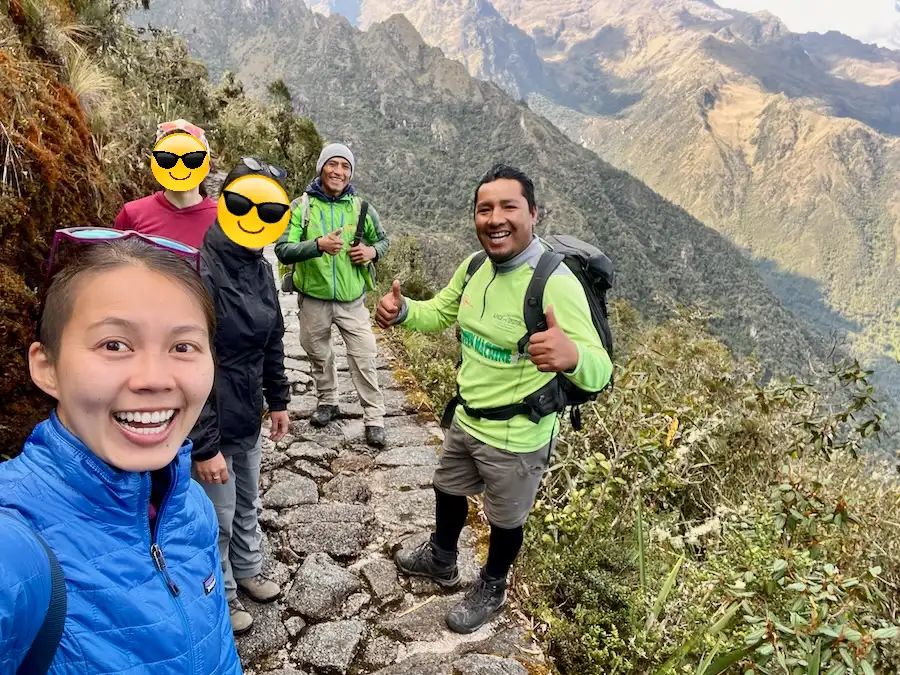
☀️ When’s the Best Time to Hike the Inca Trail?
The Inca Trail is popular enough that people hike it year-round, but the best time to hike it is during the dry season (April to October) when there’s a lower chance of rain and fog.
The rainy season runs from November to March. The high season is from June to August when the trail is the most crowded.
The Inca Trail is closed in February every year to allow the trail to recover.
📍 Where Does the Inca Trail Start?
The Inca Trail begins with an early 4 am to 5 am pickup by bus in the city of Cusco in Peru in South America.
From Cusco, you are driven about 50 miles (approximately 3 hours) to kilometer 82 on the railroad , aka “Camino Inca,” which is the start of the trail in Aguas Calientes town.
On the way to the Inca Trail start, you typically stop for breakfast at an in-between town, usually at Urubamba or Ollantaytambo.
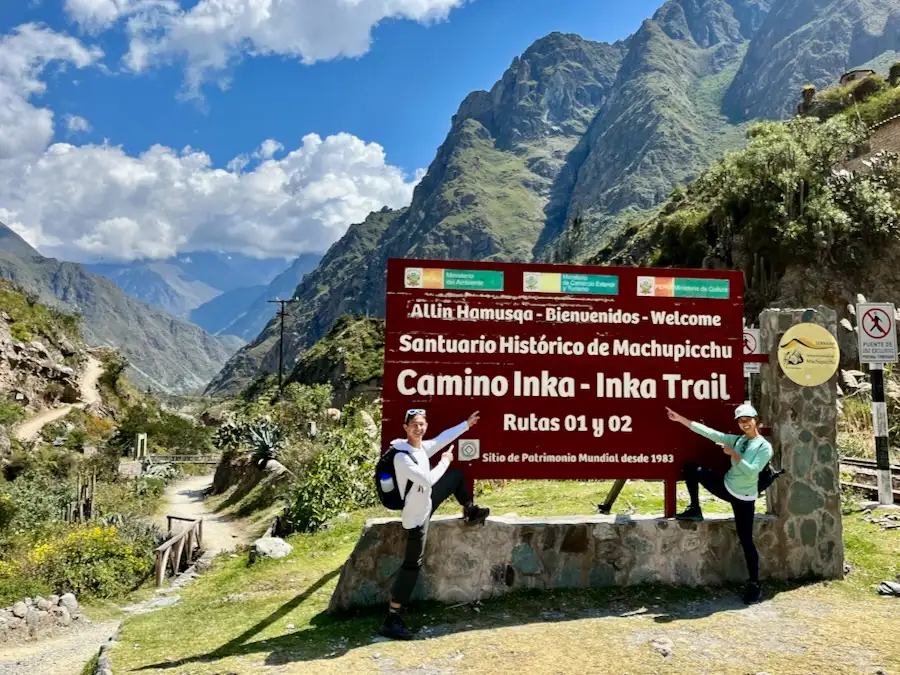
🗓️ What’s the Inca Trail Itinerary?
The classic Inca Trail hike is 26 miles of hiking and here’s what you can expect each day
Day 1 on the Inca Trail
The first day is dedicated to getting adjusted to the Inca Trail. You’ll make some stops along the way, including one at the archeological site, Patallacta, and another for lunch, before reaching the campsite around sunset.
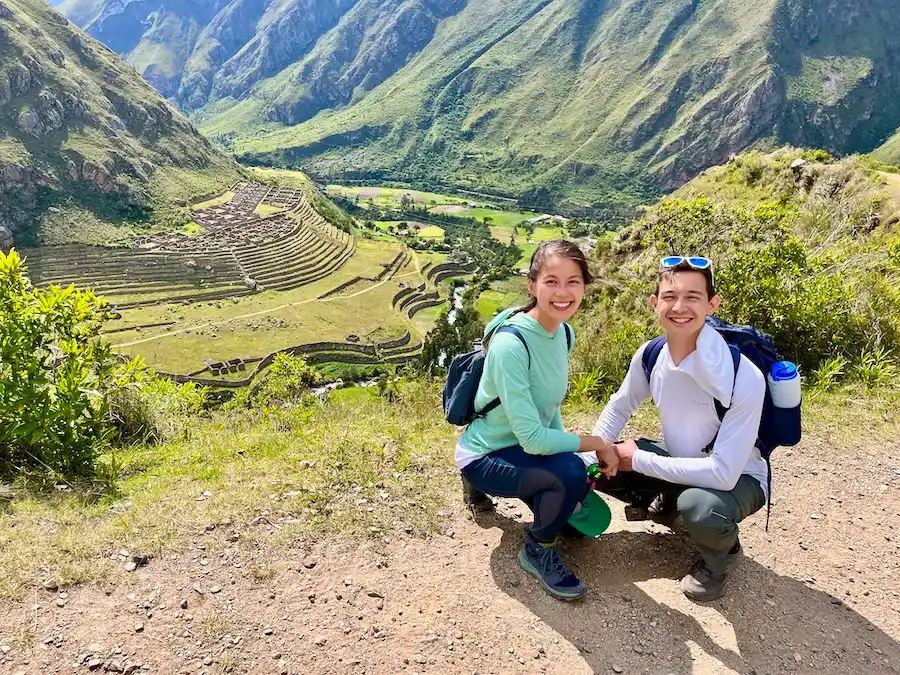
Day 2 on the Inca Trail
The second day is the most challenging day of the Inca Trail where you’ll be hiking almost entirely upwards or downwards for most of the day.
The first ascending hike is to Dead Woman’s Pass, which is the highest point on the trek (the guides fondly call it the “Gringo Killer” or “Tourist Killer”).
Day 3 on the Inca Trail
The third day of the Inca Trail is almost an entirely downhill hike and is considered one of the most beautiful days . You’ll pass by stunning views and two Inca sites, the ruins of Intipata and Wiñay Wayna.
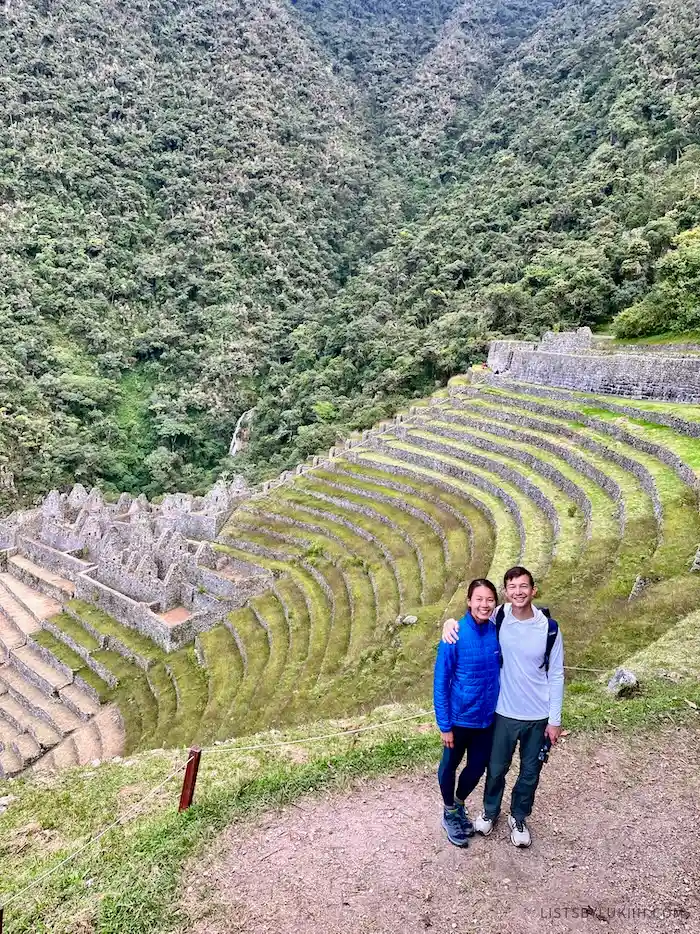
Day 4 on the Inca Trail
The last day of the Inca Trail is the easiest and most exciting day where you wake up at 3:30 am to do the Inti Punku hike to the Sun Gate and Machu Picchu.
Before concluding the tour, operators usually include a one to two-hour guided tour of Machu Picchu and the stunning Huayna Picchu mountain that rises above the ruins.
See how to incorporate the Inca Trail into your Peru itinerary .
How Much Does the Inca Trail Cost?
The cost of an Inca Trail tour ranges between $650 and $1,500 . When you’re paying for an Inca Trail tour, you’re typically paying for all the following things:
- Knowledgable guides
- Chefs who cook fresh meals along the trek
- Porters who carry everything
- Inca Trail permits
- All the camping equipment
- Machu Picchu $45 adult entrance fee
All prices mentioned here are in USD 💵 .
On average, a standard Inca Trail tour should cost around $700 to $800.
- Lower price limit – If you pay less than $650 for an Inca Trail tour, the tour operator is likely not paying its porters well. This is not socially responsible as porters are usually locals from surrounding villages.
- Upper price limit – If you paying close to $1,500, you should expect a luxury camping experience with inflatable mattresses and giant tents.
🍀 How Much I Paid for the Inca Trail
I paid $870 to hike to Machu Picchu, making it the most expensive activity I did in Peru. The Inca Trail tour cost $715 and I gave $155 for tips. See the Inca Trail tipping guide below.
I share all my travel expenses in this Peru trip cost breakdown .
Is Hiking to Machu Picchu Worth It?
More than a million people visit the ruins of Machu Picchu annually and most of them choose to see it by train and bus.
Less than 5% of visitors hike to Machu Picchu, so is it worth hiking it? To help you decide whether it’s worth hiking the Inca Trail, below are the experience’s highlights and lowlights.
🌟 Highlights of the Inca Trail
Here are some of the best things about the Inca Trail:
- Breathtaking landscapes – While Machu Picchu will be the most impressive Inca site you’ll see, the other views and ruins along the trek are remarkable and will not be nearly as crowded.
- Personal achievement – As mentioned above, the trek is not easy. Reaching Machu Picchu on foot is very satisfying. Personally, it’s one of my most memorable experiences.
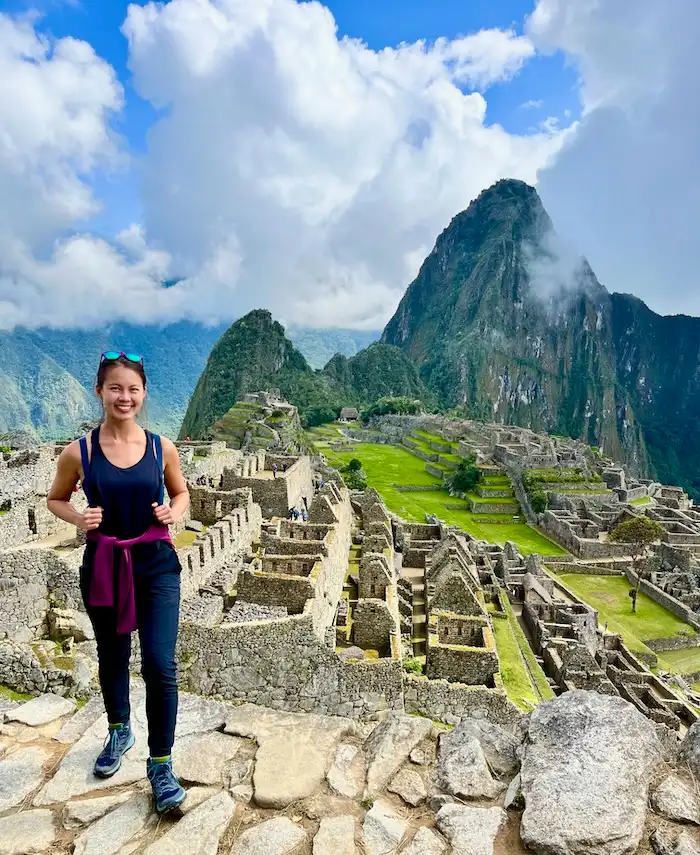
- Unplugged and unique experience – There’s no cell service for 98% of the Inca Trail, so you’ll be able to immerse yourself in the present moment of the trek.
- Incredible meals – Experienced tour operators bring well-trained chef(s) on the hike to make a feast for everyone to enjoy every night. I didn’t expect to have some of the best meals of my Peru trip while camping on the Inca Trail.
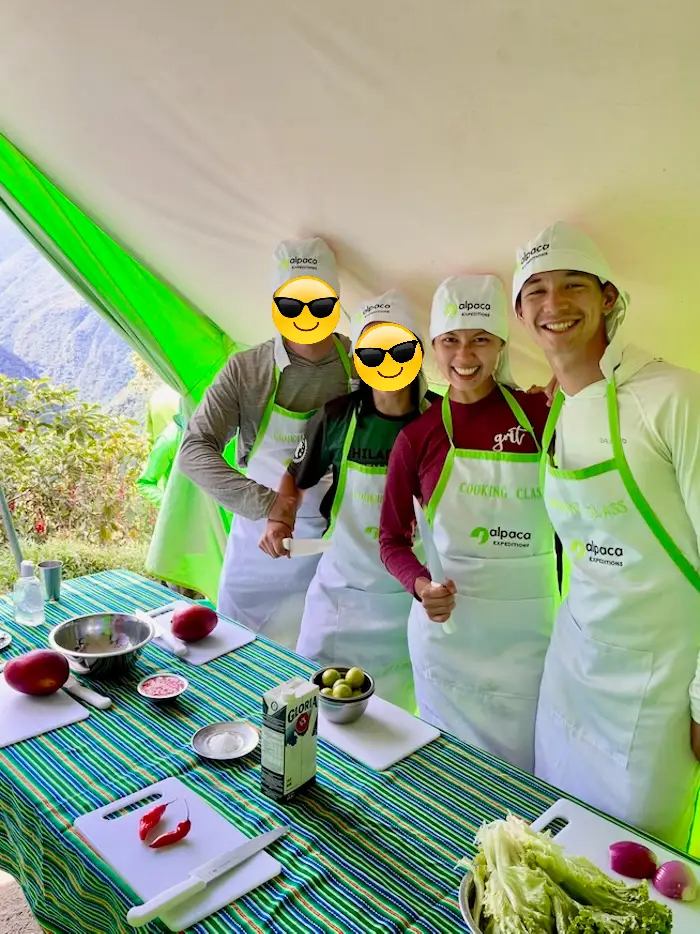
👎 Lowlights of the Inca Trail
Here are some of the worst things about the Ha Giang Loop:
- Early start every day – To have enough time for the trek, you’ll have to wake up before sunrise (5 am to 6 am), and at 3:30 am on the last day. This schedule can be exhausting for some.
- Unpredictable weather – The Inca Trail is located in the Andes Mountains and winds through a cloud forest, so if you’re unlucky, it can be foggy or rainy for most or the entire time of your trek.
Hiking during the dry season (April to November) reduces the chance of rain. I went in April and still got some foggy and rainy days, but they didn’t last long.
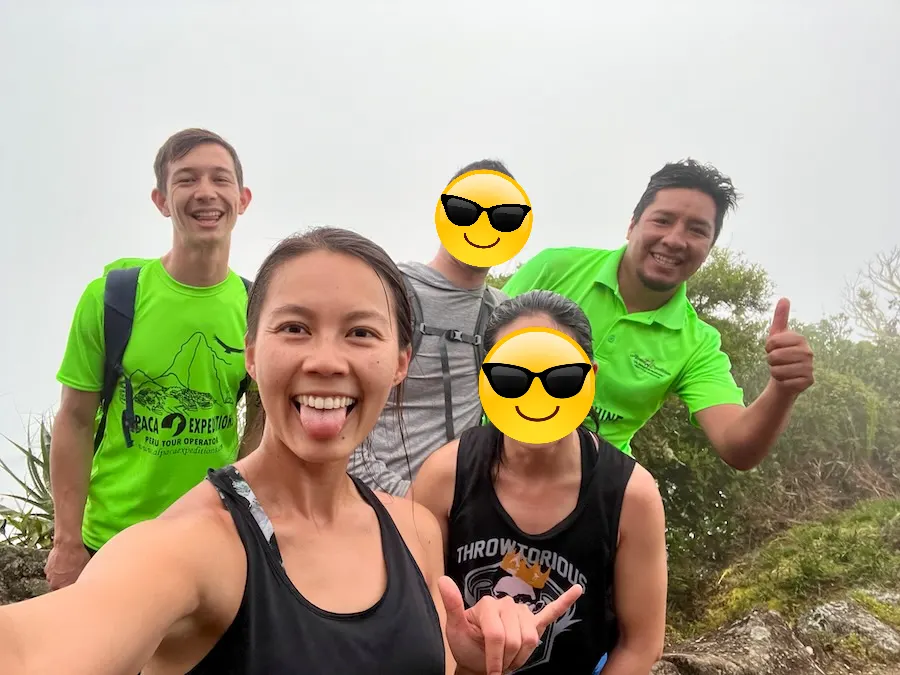
- Diverse hiking abilities – The Inca Trail is a moderate to challenging hike, so people in your group will move at different speeds. The faster group will have to inadvertently stop at certain points to wait for the rest of the group. Sometimes, this means waiting at cold stopping points for up to an hour or more (which happened to me).
- Camping is required – For people not used to camping , note that there are no cabins along the Inca Trail so you will have to camp or glamp.
The Inca Trail is a challenging trek, but it’s an unforgettable experience that holds a special place in my heart as my first multi-day hike.
Can You Hike the Inca Trail Without Camping?
Camping (or glamping) is the only accommodation option on the Inca Trail. You are in a remote mountain and there are no hotels or lodges along the route .
Some Inca Trail tour operators specialize in providing luxury camping experiences that can include things like inflatable mattresses and shower tents. Those typically cost over $1,000.
If you’re like me and don’t have much camping experience, here are three things to know about a standard Inca Trail camping experience:
🔦 1. You don’t need to bring most camping equipment.
Tour operators will provide basic camping equipment, including chairs, tables, a sleeping bag, and a two-person camping tent that you can share with someone you know or another same-gendered person in the group.
Some tour operators will provide a single tent or other equipment (e.g., sleeping pad, pillows which were included with Alpaca Expeditions, etc.) for an additional cost .
You will be required to bring some things like a headlamp, but your tour operator will let you in advance.
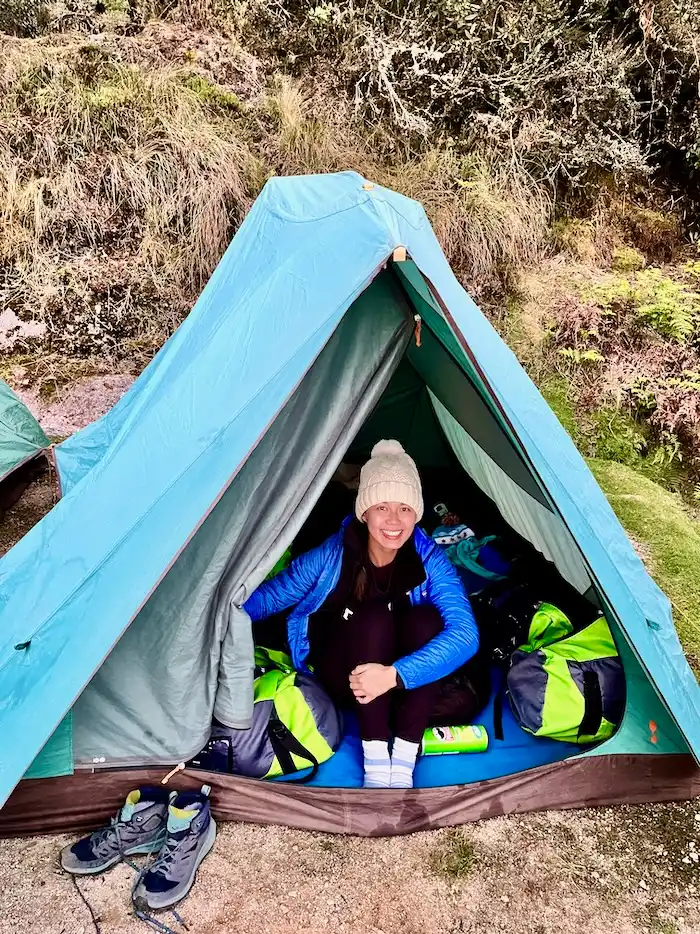
⛺️ 2. You won’t have to set up your tent.
No matter how fit you are, porters will be faster and better at hiking the Inca Trail than you, so all your equipment will arrive at each campsite before you.
Most tour operators will have tents set up by the time you arrive at each night’s campsite, but you should double-check with your operator if this is important to you.
🏕️ 3. You’ll be sharing campsites with others.
There are a limited number of campsites on the Inca Trail, so all tour groups will share spaces and facilities .
However, your group will stay close together and your group’s “space” will be clearly separate from other group’s.
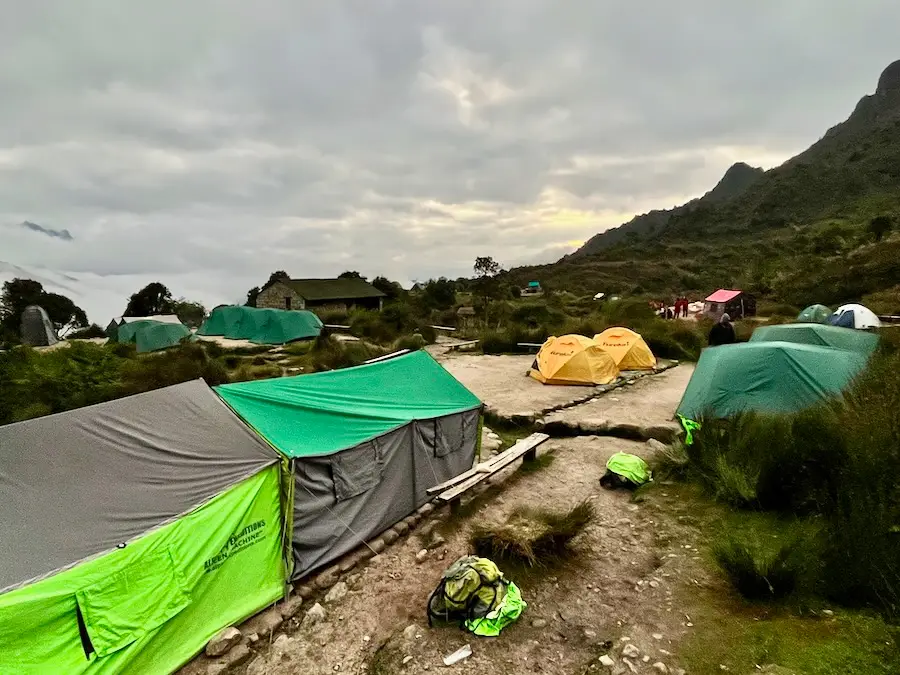
What Are Bathrooms Like on the Inca Trail?
The shower and toilet facilities on the Inca Trail will vary by stopping point and campsite.
Here are three things to know about the bathroom experience on the Inca Trail and tips on how to prepare for them:
🚽 1. Prepare to use squat toilets.
Most of the toilet facilities you’ll encounter will only have squat toilets. Also, given the trail’s remoteness and high foot traffic, they’re not going to be the cleanest toilets you’ve used.
Make sure to bring toilet paper and hand sanitizer . Some tour operators will bring TP for the group, but it’s convenient to carry some on you.
💧 2. Don’t expect hot water.
Most campsites do not provide a shower facility, and when they do, only cold water is available . Brushing your teeth will be chilly and many hikers forgo showering.
Bring large wet wipes to use. You’ll be very thankful when you sweat a lot under several layers of clothes during the colder days.
I thought I was going to shower, but I went four days without showering and I don’t regret my decision. Even if you go in the summer, it’s very cold at night at that altitude.
Even during the warmest months, the Inca Trail rarely goes above 70 °F. Most nights will dip below 40 °F .
💵 3. There are regular toilets (for a small price).
Some operators, like Alpaca Expeditions, will provide a portable toilet tent , which I found more pleasant to use than squat toilets.
Some locals set up toilets for trekkers to use for about $0.50 per person on some parts of the Inca Trail, but those are rare. Make sure you’re carrying some Peruvian soles if you want to use these.
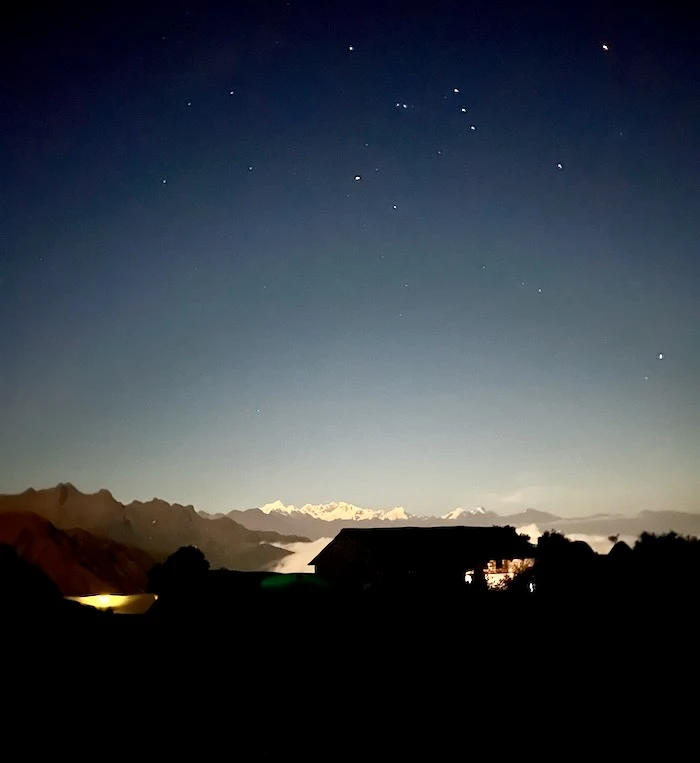
How Much To Tip on the Inca Trail
Tipping is customary and encouraged in Peru , so you should expect to tip on the Inca Trail.
The Inca Trail tipping guideline below is based on my experience and the guidelines of several established tour operators.
💰 Tipping the Inca Trail Guides
The guides are the most knowledgeable people on the trek. They lead you, ensure your safety, and provide historical and cultural knowledge.
Most Inca Trail operators will have more than one guide and it’s fairly easy to tell who the head guide is. When tipping guides, consider:
- Tipping at least $20 (or roughly 74 soles) per guide – $20 is a good baseline and you can increase that amount based on your experience. My Inca Trail group ran into a challenging scenario that required the guides to go above and beyond to take care of us, so I tipped closer to $30 to $60 per guide.
- Tipping each guide individually – Unless you’re giving all the guides the same amount, it’s best to tip individually.
- Tipping the guides at the very end – Inca Trail guides will stay with you until the end of the entire experience, so you can tip them after the Machu Picchu guided tour or lunch on the last day.
🎒 Tipping the Inca Trail Porters
The porters are the people who carry all equipment and supplies on their backs to transport things from one campsite to another. On the Inca Trail, they’re typically indigenous Quechua-speaking locals from surrounding villages.
When tipping porters, consider:
- Tipping enough so that each porter gets $10 (or roughly 37 soles) – Work with other hikers in your group to tip enough so that each porter receives at least an extra $10 for four days of labor.
- Tipping porters as a group – Since you won’t get that much exposure to the porters (they’re hiking ahead of you), you won’t know who contributed more or less, so it’s best to tip them as a group. My tour had a head porter, so we gave our tips to him to distribute fairly.
- Tipping porters on the third night – The porters do not attend the Machu Picchu tour on the last day so you’ll usually say goodbye on the night of the third day.
There’s consensus that you shouldn’t overtip porters as they often don’t have the financial education to save, meaning they may end up drinking the excess tip away for days after the trek.
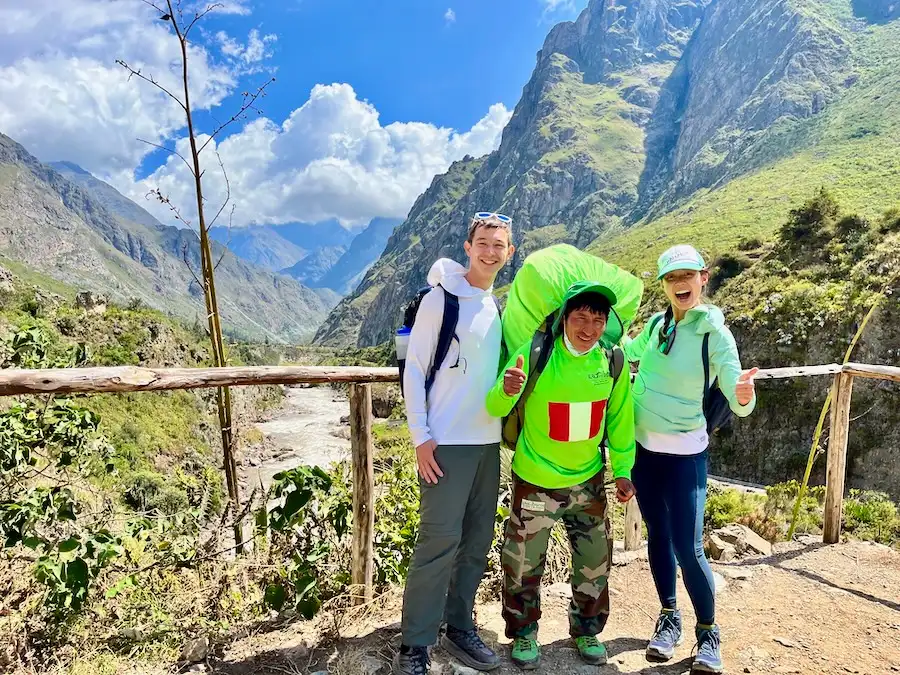
🧑🍳 Tipping the Inca Trail Chef
Tour groups will have an experienced chef who cooks all the food for everyone every night along the hike. When tipping chefs, consider:
- Tipping at least $15 (or roughly 55 soles) – Inca Trail chefs go through nontrivial training to provide their service and ensure they can cook a feast every night.
- Tipping on the third night – The chefs do not attend the Machu Picchu tour on the last day so you’ll usually say goodbye on the night of the third day.
Bring enough cash to tip the porters and chef before the start of the Inca Trail as there are no ATMs on the trail.
💵 Inca Trail Tipping Guideline
Below is a summary of how much to tip for a standard $700 to $800 Inca Trail tour.
My tip is high for the guides because my group was affected by the Peru protests , which required them to go above and beyond to take care of us.
Remember to bring small bills so it’ll be easier to break up the tips. This will also make it easier for the head porter and guide to split the tips if necessary.
Is the Inca Trail Safe?
Inca Trail guides have years of experience to ensure the comfort and safety of visitors. Every year, tens of thousands of hikers complete the trek safely .
That said, the Inca Trail is an unforgiving hike and you can run into risky or challenging situations.
Here are six bad scenarios you may run into and some tips on preparing for them.
🧠 1. Altitude Sickness on the Inca Trail
The Inca Trail has a maximum altitude of 13,828 feet, so altitude sickness is common. An estimated 50% to 85% of hikers feel some symptoms , including headache, nausea, and shortness of breath.
Here are some ways to alleviate altitude sickness:
- Arrive in Cusco one to two days early – Most hikers get to Cusco early enough to adjust to the higher elevation.
Some hotels in Cusco will provide oxygen tanks to help alleviate altitude sickness. Nicer hotels will even pump oxygen into the rooms.
- Drink coca tea or chew on coca leaves – Experimental findings and years of anecdotal evidence suggest that coca leaves can help relieve symptoms. My tour operator offered coca tea every morning on the trek, which everyone happily drank.
- Hydrate a lot – Research shows that hydration is key.
- Bring medication – If you know you’re prone to altitude sickness, come prepared with medication.
In the US, you will need a prescription from your doctor to access certain kinds of altitude sickness medication. You can find the
😥 2. Physical Inability to Complete the Inca Trail
Some people are not able to physically complete the Inca Trail on time (i.e., they can’t make it to the campsite before sunset each day). This blog tells an honest account of such an experience.
If you’re training for the Inca Trail, make sure to wear a daypack, walk on uneven terrains, and hike some hills to best replicate the conditions you’ll be facing. Hiking on a flat surface for a couple of hours is likely not sufficient.
🤢 3. Getting Sick on the Inca Trail
An experienced hiker in my group, unfortunately, got food poisoning from the food they ate before the trek.
If you get very sick on the trail, here’s what you can expect:
- Backtrack – The guide will likely ask you to turn around and not complete the trek if you haven’t yet reached Dead Woman’s Pass on day 2. The way back is easier than the way forward at that point.
- Extra support – If you can hike, an assigned guide or porter will hike with you while the rest of the group moves ahead.
- Carry you – If you can no longer hike or are hiking too slowly, porters will carry you for the remainder of the day’s hike.
While animals are not allowed on the trail, I’ve heard (but cannot verify) that they can be brought in for certain emergencies to carry sick or injured trekkers.
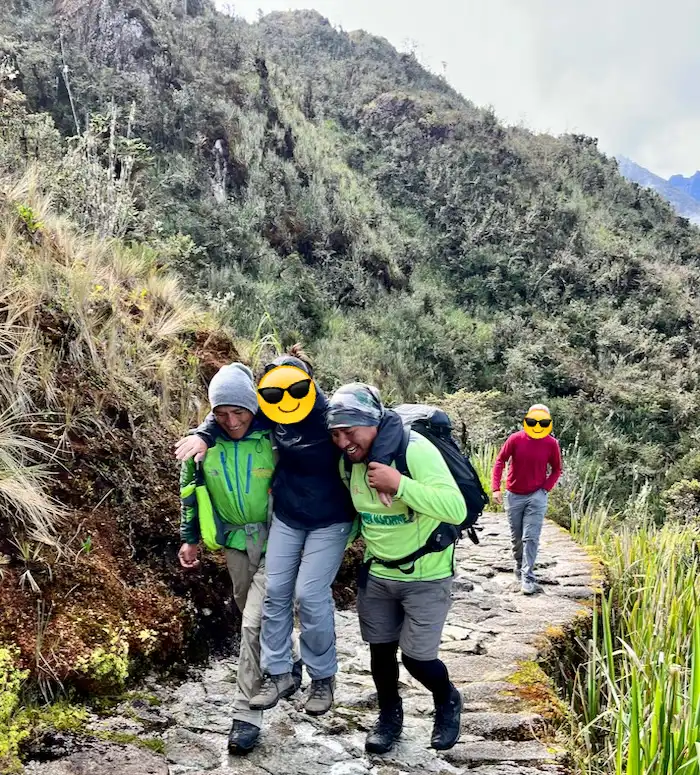
🪧 4. Getting Affected by Peru Protests
Unfortunately, protests and strikes in Peru are not uncommon and they can impact your Inca Trail trek by preventing you from getting to the starting or ending point of the trek.
My partner and I were the unlucky two people in our group to have been impacted by strikes not only right before the start, but also right after our Inca Trail hike.
Peru Protests Affecting the Start of the Inca Trail
Here are two tips to reduce the chances of your Inca Trail hike being affected by a Peru protest:
- Avoid traveling during the Peru holidays – I have since learned that protests in Peru are often planned during a holiday or busy travel time, giving the group on strike more negotiation leverage. I traveled to Cusco the weekend of Peru’s Easter holiday when we ran into protests.
- Arrive in Cusco two to three days early – Arriving more than a day in advance will give you more time to respond to a last-minute strike impacting your ability to get to Cusco.
What Happened to Us
We landed in Lima and had planned to arrive in Cusco a day before the start of our trek. An hour before our flight to Cusco, all of Peru’s air traffic control went on strike and all flights were canceled for the day.
We looked for alternative ways to get to Cusco in the next 24 hours with no luck (e.g., the drive is long and potentially unsafe, and a bus journey would take more than 30 hours).
After hours of disappointment and frustration, we managed to get on a flight that would land at 10 am on the first day of our Inca Trail hike. We had to coordinate with Alpaca Expeditions to see if it was feasible to make our trek since our group was scheduled to leave Cusco at 6 am.
Alpaca Expeditions left two porters and one guide behind to meet us at Cusco. We got off the plane, took a taxi straight to the start of the trail, and caught up to our group by taking fewer rests and making fewer stops along the way.
Making our Inca Trail trek given the above circumstances required a few things to come together:
- The tour operator has to be collaborative – Alpaca Expeditions’s willingness to be flexible and coordinate with us allowed us to make the trek. This is why choosing a tour operator with a good track record is important.
- The strike ended – Peru’s air traffic control strike ended within 24 hours, so we could get on a flight the next day.
- Flight availability – We called the airlines every hour to check availability. After racking up $50 worth of international phone bills, we were put on a flight around midnight, about six hours before our Inca Trail group departed.
- Hiking ability – We’re generally strong hikers, and despite the five-hour deficit, we were able to catch up to our group.
Peru Protests Affecting the End of the Inca Trail
After finishing our 26-mile trek on the Inca Trail, we received news that the trains back to Cusco were not running due to more protests .
Our group was given two options:
- Stay in Aguas Calientes until the strike ends – This was the safer option, but there was no way of knowing how long the strike would last (hours or days?), and some of us had to catch flights out of Cusco.
- Hike an additional four hours to a bus stop and get on an eight-hour bus drive back to Cusco – The strikes caused road blockages which meant the train couldn’t run and buses couldn’t go through regular roads, so buses had to take the backroads.
Most of our group chose the second option and thus began our 12-hour journey back to Cusco after an exhausting four-day trek.
The additional hike and bus ride was exhausting, frustrating, and anxiety-inducing for everyone. Having survived it, it is now one of my most memorable experiences.
If you’re unlucky enough to face a similar situation during your Inca Trail hike, here are my three pieces of advice:
- Pack plenty of snacks and water – It wasn’t immediately obvious how long the journey back to Cusco would take and after a four-day hike, you will likely get hungry quickly. My group didn’t pack enough snacks and had to quickly buy water at the last minute.
- If you’re risk-averse, stay in Aguas Calientes – The unexpected, additional four-hour hike on the railroad tracks was unpleasant, but doable. The eight-hour bus ride through the backroads was terrifying for even the most adventurous of us. It might be worth missing your flight to avoid this bus ride.
- Pack headlamps – We spent two hours walking in almost complete darkness by the railroad track and people who didn’t bring headlamps had to stick to people who did. I was one of those people without a headlamp and can now say in that situation, you’ll want your own.
☠️ 5. Deaths on the Inca Trail
The worst of the bad scenarios on the Inca Trail is fatalities. Deaths are very rare given how many people hike the trail annually, but they do happen.
Deaths on the Inca Trail occur primarily for three reasons:
- The victim was not paying attention – In 2013, a hiker slipped and fell off a ledge. In 2016, a hiker fell while posing for a photo.
- The victim was extremely unlucky – In 2004, a hiker was struck by lightning. In 2010 and 2020, heavy downpours led to a landslide that led to three deaths.
- The victim had health issues – In 2022, a tourist died because his health issue was exacerbated by the Inca Trail’s high altitude and difficulty.
This is all to say that no matter how tired you are, you should always pay attention to your surroundings while hiking the Inca Trail.
At certain points, Alpaca Expeditions’s guides would remind us to stick close to the mountainside when passing others and ensure no one in the group got too close to the ledge during photos.
🌧️ 6. Bad Weather on the Inca Trail
Since the Inca Trail is located on Andes Mountain, it can get foggy and rainy at any time of the year, leading to low visibility and slippery terrain.
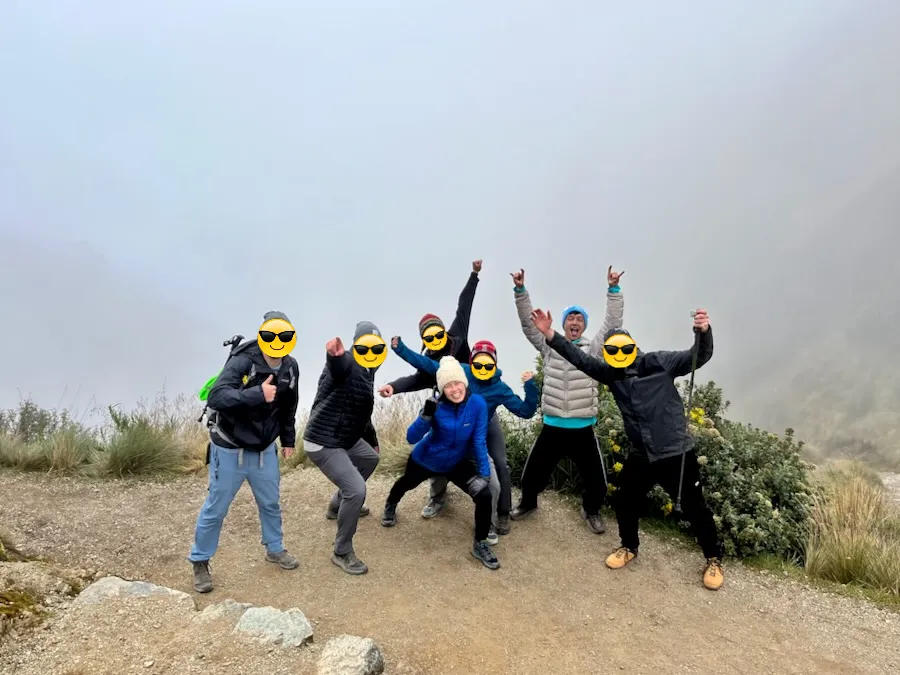
Here are two tips when preparing for and dealing with bad weather on the Inca Trail:
- Pack for rain and cold, and ensure you have good hiking shoes – The Inca Trail’s average temperature varies throughout the year, but it’s rarely warmer than the mid-70° Fs. Make sure to pack warm, waterproof layers and comfortable, waterproof hiking shoes with good traction.
The wet season runs from November to March.
- Be careful when passing other hikers, especially on day 4 – Given the Inca Trail’s popularity, you will likely get passed or pass others at some point on the trail. In some instances, the passing will occur next to steep ledges while the ground is slick.
Day 4 is the most crowded day and many hikers will try to pass each other trying to be one of the firsts to reach Machu Picchu. When I did the trek, it was raining on day 4 and I saw hikers jog and squeeze past others in precarious areas.
What to Pack for the Inca Trail
One of the best ways to ensure you have an enjoyable trek on the Inca trail is to pack well while staying under your bag’s weight limit .
By law, each porter is allowed to carry up to 44 lbs of weight. Alpaca Expeditions limited each person to 15 lbs of things they could bring, including a sleeping bag and pad, for porters to carry.
Below is a comprehensive Inca Trail packing list with essential items.
The Peru trip planner below has this packing list in a downloadable Notion.
- Waterproof hiking shoes – Bring waterproof hiking boots that you’ll feel comfortable hiking in for four days; test them in advance for multiple days to ensure you won’t get blisters. Some ankle support is also recommended.
- Comfortable shoes for camp – You’ll spend three to five hours each day at the campsite and will want to walk around in something other than your hiking shoes. Something lightweight and easy to slip on and off like a pair of Crocs is great.
When packing clothes for the Inca Trail, remember that during even the warmest months, it rarely goes above 70 °F, and most nights will dip into the 30s °F and 40s °F.
- Warm hiking socks (4 sets) – You’ll be hiking for hours each day so maximize your comfort with hiking socks that have cushions and are moisture-wicking. Ensure they’re also warm for the chilly nights.
- Warm base layer (top and bottom) – Bring a warm top and bottom base for when the sun goes down. I brought my Merino wool top and bottom which keeps me warm, but also doesn’t become suffocating when it’s hot.
- Moisture-wicking tops (3-4) – I brought 2 lightweight athletic tanks and 2 sun hoodies that didn’t take up much space. It was nice having fresh clothes for each day, but that’s not necessary if you want to save space or weight.
- Hiking pants and leggings (2-3) – Bring at least one bottom for warmer weather and one for cooler weather. I brought a pair of hiking pants and leggings.
- Undergarments (4)
- Warm, down jacket – You’ll need a warm jacket at high elevations. During the cold nights, you might even sleep in it.
- Fleece layer – For colder nights, you’ll need another layer underneath your down jacket.
- Waterproof gloves – You’ll want gloves at high elevations and you’ll especially want them if you’re using hiking poles.
- Warm hat – You’ll need a warm hat during the night and for sleeping. On the colder days or in the early mornings, you’ll also likely hike in it.
- Sun hat – There are days when you’ll be exposed to the sun without shade for hours, so bring a hat.
- Rain gear – Moments of rain are common on the Inca Trail even during the dry season. Some tour operators will provide rain ponchos. I brought my light rain jacket that I could easily layer over my down jacket or fleece layer as a windbreaker.
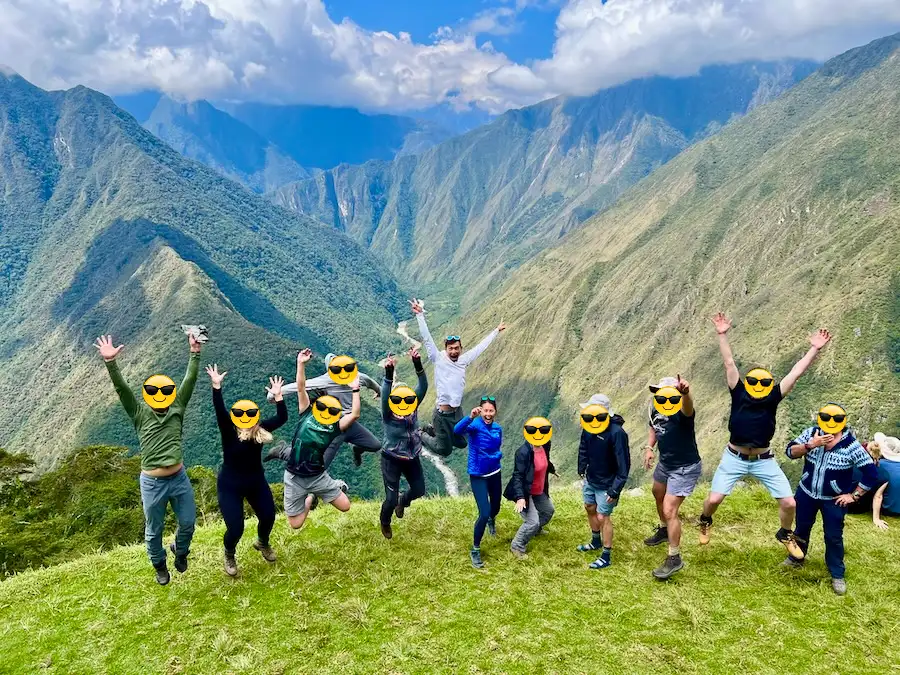
🧼 Personal Items
- Wet wipes – Since you likely won’t shower, bring large wet wipes to feel more refreshed. You’ll be thankful when you sweat a lot under several layers of clothes during the colder days.
- Soap – Bring a bit of soap to wash your face and hands every night. Alpaca Expeditions provided each trekker with a warm bowl of water to freshen up each night.
- Toothbrush and toothpaste
- Earplugs (optional) – Your group’s tents will be set up close to each other, so if you’re a light sleeper, you’ll want earplugs in case someone snores and shifts a lot at night. I brought mine and it helped a lot
- Sleeping mask (optional) – If you have trouble sleeping in tents or outside, a sleeping mask can help.
- Quick-dry towel (optional) – Some tour operators will provide you with a small towel to dry your face and hands after washing them. Otherwise, bring a quick dry towel .
- Hair tie (optional) – Don’t forget to bring a hair tie if you have long hair.
🔋 Miscellaneous
- Original passport – Your passport will be checked before you start your Inca Trail hike as foreigners need a valid one to enter Machu Picchu.
- Battery pack – There are no places to charge on the Inca Trail, so bring a fully charged battery pack if you want to take photos with your phone or need to recharge your headlamp.
- Large plastic bags (optional) – Bring a large plastic bag to keep dirty and clean clothes separate and to help keep things somewhat organized inside your porter’s duffel bag.
- Hiking poles (optional) – A couple of us didn’t have hiking poles and were fine, but in retrospect, they would have been helpful. This is especially true during day 2 when it’s almost entirely an uphill and downhill hike. You can rent one from your tour operator or bring one in advance.
🎒 Daypack Items
Aside from the bag that your porter will carry that has a weight limit, you will also need to carry a daypack during your hike. Here are the items to pack in your Inca Trail daypack.
- Reusable water bottle – Your tour operator will provide filtered water every day, but you need to bring your own water bottle to get it refilled. Because you only get a refill once a day, I recommend bringing a large water bottle like this one (which is what I brought).
- Sunscreen – Bring sunscreen since there are days you’ll be exposed to the sun for hours if the weather holds up. This is a great sports sunscreen I pack everywhere now, but if you want something lighter since you likely won’t shower, I packed this sunscreen .
- Sunglasses – There are days when you’ll be exposed to the sun for hours, so bring sunglasses. I brought my athletic pair of sunglasses .
- Headlamps – You’ll need headlamps to navigate at night around the campsite and during the mornings since you’ll always wake up before sunrise and may even hike in the dark for a bit.
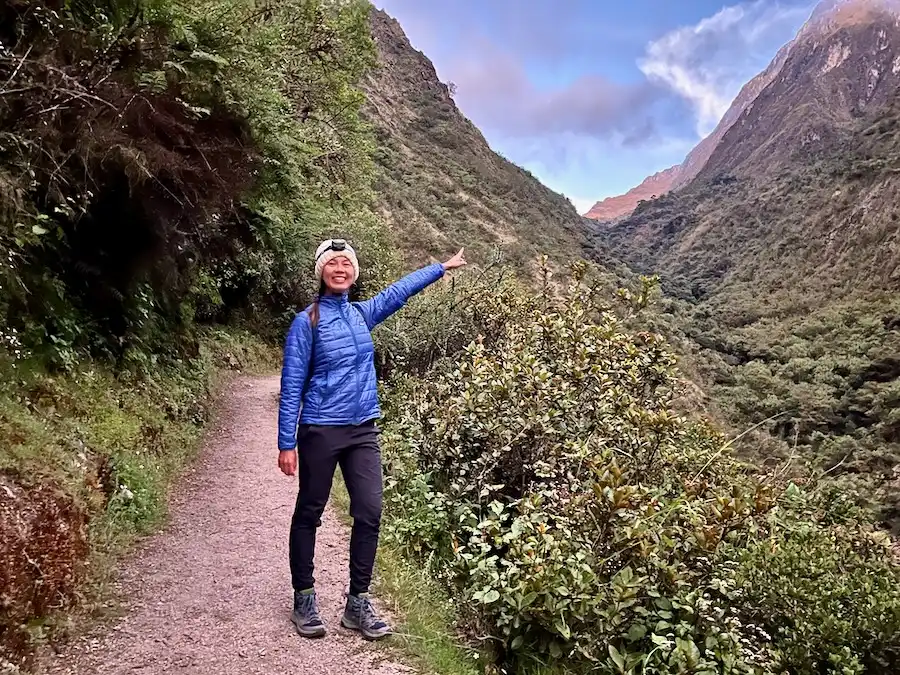
- Hand sanitizer – The Inca Trail bathroom facilities often don’t have soap, so bring hand sanitizer. You’ll also want it when you need a snack and there are no facilities around.
- Toilet paper – Bring a stash of toilet paper as most bathroom facilities won’t have them. I carried a few in a zip-lock bag. Some tour operators will bring TP for the group, but it’s convenient to carry some on you.
- Cash – Bring cash to tip your guides, porters, and chefs and to buy snacks at certain stopping points on the Inca Trail.
- Insect repellent (optional) – There are some mosquitos on the Inca Trail, but the cold and elevation make them uncommon. Unless it’s a sunny day, you’ll also be mostly covered up.
- Altitude sickness medication (optional) – You need a prescription for these in the US, but you can get them over the counter in Peru pharmacies.
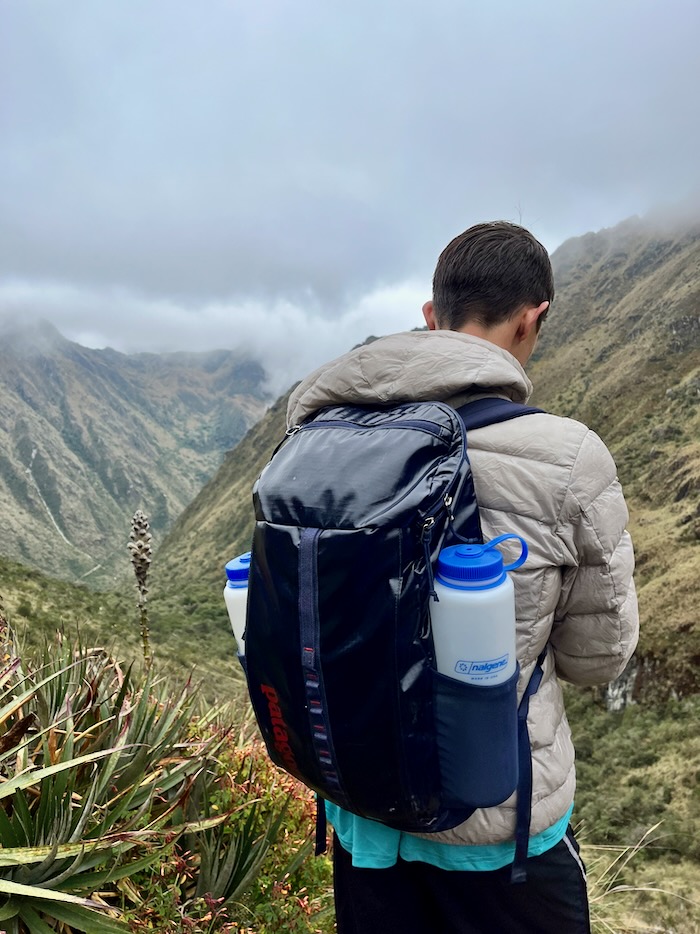
The Inca Trail is an unforgettable experience and there are good reasons why it’s on many people’s bucket lists. Good luck on your hike!
To make your travel planning easier , download the trip planner below and use it as a starting point. The planner has country-specific travel information, an itinerary, a packing list, and a map with key places pinned.
The trip planner is built on Notion, which I use for all my travel planning (I genuinely love this tool). If you don’t have Notion, creating an account is free .
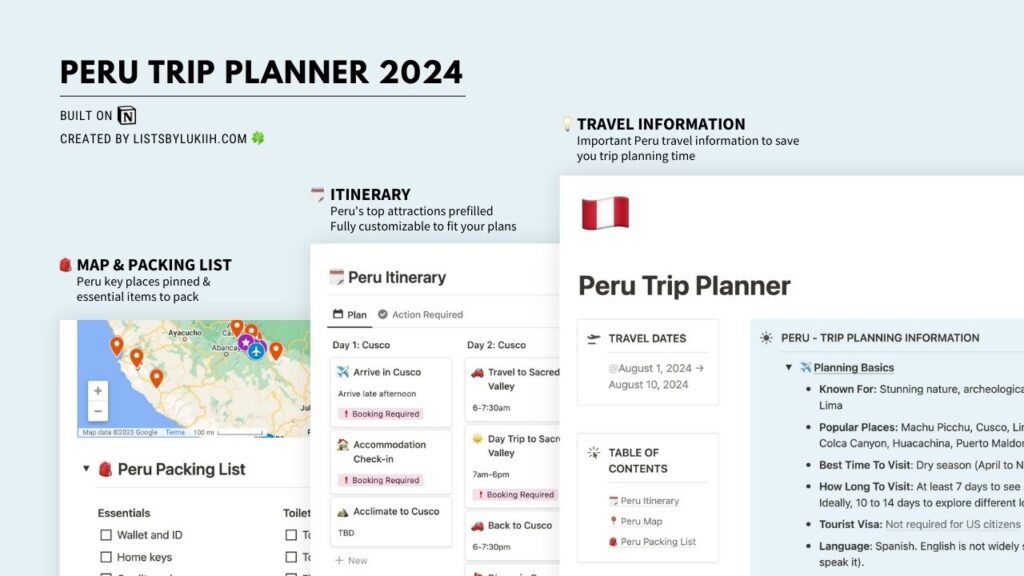
Thoughts? Questions? Leave a comment below .
Peru Travel Guides
- 🇵🇪 Planning a Trip to Peru: 11 Practical Things To Know
- ⛰️ 10 Adventurous Days in Peru: An Efficient Itinerary
- ☀️ Inca Trail Hike Practical Guide: Risks & Firsthand Tips
- 🏂🏻 Huacachina Day Trip: Sandboarding & What To Wear
- 💰 My 2024 Peru Trip Cost: A Budget Breakdown
Lists by Lukiih is Readers-Supported
If you find my travel tips helpful, say thanks with a bubble tea 🧋!
Thanks for your elaborate trip review. Definitely it will assist traveler who wants to visit PERU,,,,
Glad you found it helpful, Ashad!
Leave a Reply Cancel reply
Your email address will not be published. Required fields are marked *
Save my name, email, and website in this browser for the next time I comment.

- Information
Inca Trail Weather along the trek to Machu Picchu
Weather can make a big difference on your Inca Trail trek. Heavy rain, freezing nights, scorching sun and hurricane force winds are possible on your trek to Machu Picchu. If you pick the right months though (see below), the days will generally be warm and dry, and the nights mostly above freezing. Just make sure you pack warm clothes for the evenings and a decent sleeping bag.
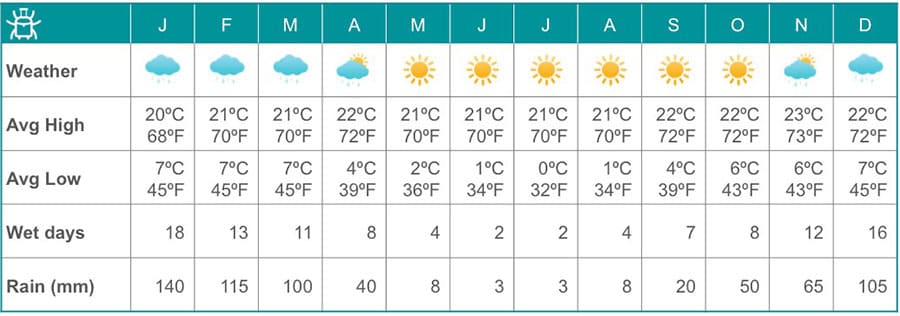
Cusco Weather
Cusco's climate is divided into two seasons: the rainy season, from November to April (the heaviest rains generally occur between January and March); and the dry season, from May to September. The rainy season from November to April has a tropical downpour. Heavy, but the rains usually do not last long or the rain is often at night.
Machu Picchu and Inca Trail Weather
Along the Inca Trail (May to September, high tourist season), temperatures range from 15-20ºC (59°F-68°F) during the day if it is sunny, and from 05-10ºC (41°F-50°F) during the day if it is not sunny and from 0-05ºC(32°F-41°F) during the night in between the first and second campsites. In Wiñaywayna and Machu Picchu, which is a subtropical zone, at a lower altitude, temperatures are usually warmer, although warm clothing is still recommended at night. The Inca Trail is closed for maintenance throughout the month of February. The low season can be a time when you can enjoy Salkantay Trek, Inka Jungle to Machu Picchu without the crowds of people.
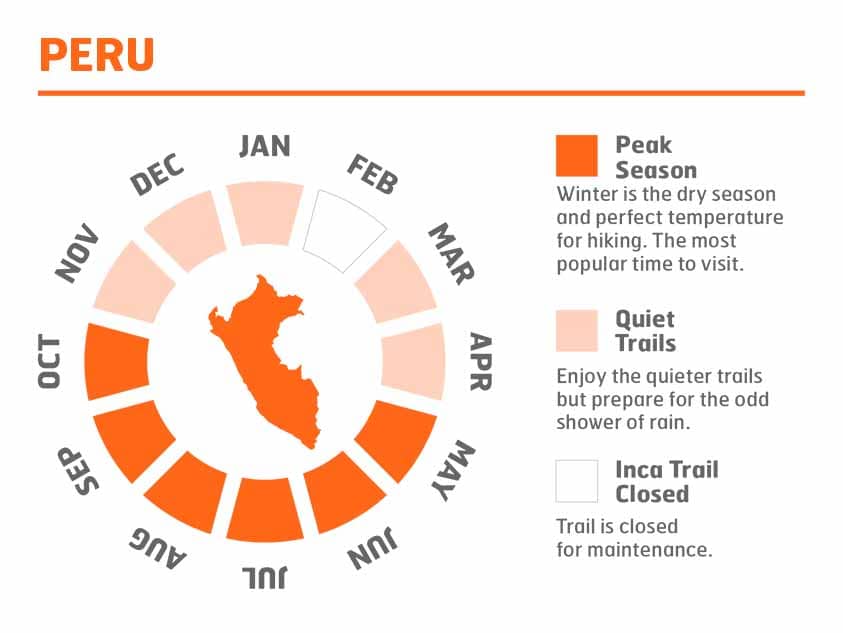
Why Life Adventures Travel SAC?
We are travel experts.
Fully customizable Inca Trail.
24/7 support from our experts tours.

- Legal Information
- Terms & Conditions
- Personal Data Protection
- Payment Methods
- Cusco City Tour (Half Day)
- Maras Moray Tour on Bicycle
- Maras Moray Tour on ATV Quad Bike (Half Day)
- Maras Moray Tour (Half Day)
- Rainbow Mountain Trek (Vinicunca)
- Rainbow Mountain Tour (Palccoyo)
- Pallay Punchu Rainbow Mountain Tour (Full Day)
- Classic Sacred Valley (Day Trip)
- Sacred Valley VIP (Day Trip)
- Complete Sacred Valley VIP (Private Day Trip)
- Sacred Valley Tour from Ollantaytambo (Full Day)
- South Valley Tour (Half Day)
- Humantay Lake (Day Trip)
- Waqrapukara Trek (Day Trip)
- Qeswachaka (Day Trip)
- Inkilltambo Trek (One Day)
- Condor Sighting in Chonta (Day Trip)
- Machu Picchu Day Trip from Cusco (By Train)
- Machu Picchu (2 Days) By Train
- Machu Picchu (2 Days) By Car
- Sacred Valley Connection to Machu Picchu (2 Days)
- Machu Picchu Huayna Picchu Tour (Two Days)
- Lake Titicaca (Half Day)
- Lake Titicaca (Day Trip)
- Lake Titicaca (2 Days)
- Manu Jungle Tour (3 Days)
- Manu Jungle Tour (4 Days)
- Manu Reserved Zone (5 Days)
- Lake Sandoval (2 Days)
- Tambopata Clay Lick (3 Days)
- Tambopata Eco Tour (4 Days)
- Uyuni Salt Flats (Day Trip)
- Uyuni Salt Flats Trip (3 Days)
- Inca Jungle Trek to Machu Picchu (3 Days)
- Inca Jungle Trek to Machu Picchu (4 Days)
- Inca Trail to Machu Picchu (Day Trip)
- Inca Trail to Machu Picchu (2 Days)
- Inca Trail to Machu Picchu (3 Days)
- Inca Trail to Machu Picchu (4 Days)
- Salkantay Trek to Machu Picchu (3 Days)
- Salkantay Trek to Machu Picchu (4 Days)
- Salkantay Trek to Machu Picchu (5 Days)
- Lares Valley Cultural Trek (3 Days)
- Lares Trek (4 Days)
- Choquequirao Trek (5 Days)
- Choquequirao Trek to Machu Picchu (9 Days)
- Choquequirao Vilcabamba Trek to Machu Picchu (10 Days)
- Vilcabamba Trek to Machu Picchu (5 Days)
- Espiritu Pampa Vilcabamba Trek (7 Days)
- Ausangate Trek to Rainbow Mountains (4 Days)
- Ausangate Trek (5 Days)
- Ausangate Sibinacocha Trek (6 Days)
- Ancascocha Trek to Machu Picchu (4 Days)
- Inca Quarry Trail (Day Trip)
- Cachicata Trek (Day Trip)
- Huchuy Qosqo Trek to Machu Picchu (3 Days)
- Machu Picchu Travel Package (5 Days)

Inca Jungle Trek Weather Tips: Staying Comfortable
The Inca Jungle Trek is a breathtaking adventure. However, the Inca Jungle Trek Weather diverse climate can be unpredictable. Being prepared is essential.
From dense rainforests to towering mountains, the trail offers varying conditions. Understanding these weather patterns ensures a comfortable journey. Here, we’ll share some crucial weather tips.
Whether you’re a seasoned trekker or a first-timer, staying comfortable is key. With the right knowledge, you can conquer the trail’s challenges. Let’s dive into these weather insights.
Packing right: Essentials for all Inca Jungle Trek Weather conditions
The Inca Jungle Trek is a dream for many adventurers. Its landscapes are vast and varied. This means diverse weather conditions.
Preparing for the Inca Jungle Trek weather is essential for a pleasant journey. Here are the essentials for every twist and turn.
First, consider the weather at Humantay Lake . It’s colder, especially during evenings.
Pack thermal layers, gloves, and a beanie. Lightweight, warm jackets are indispensable too. They’ll keep you cozy without adding much weight.
Next, focus on rain gear and equipment. Inca Jungle Trek weather can be wet, especially in the rainforest. Waterproof jackets, ponchos, and trousers are essential.
Don’t forget moisture-wicking socks and waterproof boots. They’ll keep your feet dry and comfortable.
Rafting in the Inca Jungle Trek ? It’s a thrilling experience.
To enjoy it fully, bring quick-dry clothing. A good-quality, waterproof bag is a must. It’ll protect your essentials from splashes and rain.
The sun can be strong during the day. Sun hats, UV-protective sunglasses, and sunscreen are important.
They’ll shield you from harmful UV rays. Staying hydrated is vital, too. Carry a reusable water bottle everywhere.
Trekking the Inca trail also demands energy. Snacks are essential for keeping up your strength. Opt for lightweight, high-calorie foods like nuts. Also, include energy bars and dried fruits in your pack.
Lastly, the Inca Jungle Trek weather is unpredictable. Always check the forecast before heading out. Even then, expect the unexpected. Being adaptable and well-prepared ensures an enjoyable trek.
Remember, packing right can make or break your experience. Equip yourself for every Inca Jungle Trek weather condition. This guarantees not just comfort, but memorable adventures too.

Staying dry and cool: Strategies for managing Inca Jungle Trek Weather
The Inca Jungle Trek weaves through diverse terrains. This leads to varying and often unexpected weather conditions. Adapting to the Inca Jungle Trek weather becomes a primary concern.
Humidity can be high in certain regions. Wearing moisture-wicking clothes is a good strategy. These fabrics pull sweat away from your skin. As a result, you stay cooler during challenging climbs.
Direct sunlight is another factor. Avoid trekking during the hottest parts of the day. Aim for early mornings or late afternoons. This approach not only keeps you cool but also conserves energy.
Another challenge is the rain. Inca Jungle Trek weather can surprise with sudden downpours. Always carry a lightweight, waterproof jacket or poncho. Keep it within easy reach in your backpack.
Footwear plays a crucial role too. Wet feet can lead to blisters and discomfort. Invest in waterproof hiking boots. They provide grip, support, and keep feet dry.
Your Inca Jungle Trek packing list should include wide-brimmed hats. They shield your face and neck from the sun. Regularly applying sunscreen is another vital strategy. It prevents sunburns and longer-term skin damage.
Hydration cannot be stressed enough. The Inca Jungle Trek demands a lot from trekkers. Always carry enough water. Refill at designated spots along the trail.
Finally, always be informed. Before starting your journey, check the weather forecast. Familiarize yourself with the Inca Jungle Trek weather patterns. This helps you anticipate and prepare accordingly.
By mastering these strategies, you’ll navigate the Inca Jungle Trek confidently. You’ll stay both dry and cool. The trek becomes more about the journey, less about battling the elements. Remember, it’s about enjoying every step.

Adapting to nature: Making the most of Inca Jungle Trek Weather
The Inca Jungle Trek is more than just a trail. It’s a journey through nature’s vast palette. Every twist offers diverse weather conditions. But instead of battling them, how about embracing them?
Sunshine can be your ally. The golden hours, just after sunrise or before sunset, paint landscapes beautifully. They’re perfect for photography enthusiasts. Capture memories that last a lifetime.
When rains surprise you, embrace the change. Rain can bring out the lushness of the forest. The scent of wet earth, the sound of raindrops – they’re therapeutic. It’s nature’s way of refreshing everything around.
Cold mornings in the mountains? They come with crystal clear skies. As you trek higher, watch the world awaken below. The chilly breeze, the sun’s first rays; they’re invigorating.
But sometimes, weather can challenge your spirits. It’s essential to stay positive. Remember, it’s all part of the experience. These challenges make reaching your destination even more rewarding.
Another tactic is staying prepared. Knowledge is your most potent tool.
Familiarize yourself with the trail’s weather patterns. This helps you plan better and pack right. A well-packed backpack is half the battle won.
Hydrate, rest, and keep your energy levels up. The trail might test your stamina. But with the right mindset, every hurdle becomes a memorable story.
Now, after conquering the Inca Jungle Trail, what’s next? If you’re still thirsty for more adventures, we have a suggestion. Consider taking the Palccoyo Rainbow Mountain Tour . It offers landscapes that seem straight out of dreams.
Or if you’re looking to combine history with nature, there’s another treat. Embark on the Inca Jungle Trek to Machu Picchu Cusco. Dive deep into the mysteries of ancient civilizations while surrounded by breathtaking scenery.
Nature is unpredictable, but therein lies its beauty. Adapt, embrace, and let the Inca Jungle Trek weather be a part of your story. After all, adventures are best when unexpected.

Why Book With Us?
- No-hassle best price guarantee
- Customer care available 24/7
- Hand-picked Tours & Activities
- Excellent safety standards
Got a Question?
Do not hesitate to give us a call. We are an expert team and we are happy to talk to you.
+51 973 124 984

Proceed Booking
Already a member.
Username or E-mail
Forget Password?
Don't have an account? Create one.

Ultimate Guide to Hiking the Inca Trail to Machu Picchu: Tips and Trails for Your Peru Trek
Embarking on the legendary Inca Trail to the mystical ruins of Machu Picchu is truly a transformative adventure that every hiker dreams of.
But let’s be real, it’s not as simple as just lacing up your boots and hitting the trail. This guide is here to be your ultimate companion, filled with practical insights to help you navigate the challenges and make the most of your journey.
Trust me, I’ve been there too. I know what it’s like to face the fear of the unknown – the unfamiliar terrain, the altitude sickness , and the uncertainty about the right gear.
My first-hand experience completing this trek has shaped this guide, and I want to share that authentic experience with you.
I want to empower you to not only conquer the Inca Trail but any hiking adventure that lies ahead.
Whether you’re a seasoned hiker or just a curious adventurer, this guide will equip you with the knowledge and the courage to embark on the journey of a lifetime.
What is the Inca Trail?
The Inca Trail is this amazing four-day trek that follows the path of an ancient Inca highway that was built over 500 years ago.
You start at this point called Kilometer 82, just outside the city of Cusco , and it takes you all the way to the Sun Gate, where you get this breathtaking view of Machu Picchu .
And let me tell you, along the way, you’ll come across so many Inca ruins and get to experience the sheer beauty of the Andes mountains. It’s truly something!

Choosing the Right Trail
Before you set off on this epic journey, it’s crucial to understand the factors involved in choosing the right trail.
In the following sections, we’ll explore the different Inca Trails available, the difficulty levels they offer, and the permits and regulations you need to consider.
The Classic Inca Trail
The Classic Inca Trail is the ultimate route that has fascinated hikers for ages. Picture ancient ruins, lush cloud forests, and breathtaking views of the Andes.
It usually takes around four days to finish, covering roughly 26 miles (42 kilometers). So, ready to embark on this incredible adventure?
.jpg)
Salkantay Trek
The Salkantay Trek is a tough but exciting alternative to the Classic Inca Trail. It’ll take you through a variety of landscapes like snow-capped mountains, high-altitude passes, and lush tropical cloud forests.
It’s perfect for those who want a more adventurous and off-the-beaten-path experience!
The Lares Trek offers a unique opportunity to immerse yourself in the local Andean culture.
This trail takes you through traditional Andean villages, where you can interact with indigenous communities and witness their way of life. The Lares Trek is also less crowded compared to the Classic Inca Trail.
Choquequirao Trek
If you’re an adventurous hiker seeking a challenging and off-the-beaten-path experience, you should definitely consider the Choquequirao Trek.
This trail will lead you to the lesser-known Inca site of Choquequirao, often called the “sister city” of Machu Picchu.
Along the way, you’ll be treated to breathtaking views of the Vilcabamba mountain range and have the chance to explore ancient ruins. It’s a real gem for adventure seekers!
Difficulty Levels
When it comes to choosing a trail, it’s important to find one that matches your fitness level and hiking experience.
The Classic Inca Trail is moderately challenging, with steep ascents and descents, high altitudes, and long hiking days.
On the other hand, the Salkantay Trek and Choquequirao Trek are more demanding, requiring a higher level of physical fitness and endurance.
If you’re looking for a slightly less strenuous option that still offers a great balance between cultural immersion and hiking, the Lares Trek is a popular choice.
Permits and Regulations
If you’re planning to hike the Inca Trail, including the Classic Inca Trail, you’ll need to get a permit.
These permits are limited and go fast, especially during the peak season from May to September.
So, it’s a good idea to book your trek well in advance to secure your permit. And remember, it’s important to follow the rules set by the Peruvian government and the Ministry of Culture.
These rules cover things like waste management, camping restrictions, and protecting the archaeological sites along the trail. By respecting these rules, we can preserve this ancient trail for future generations to enjoy.

Why Hike the Inca Trail to Machu Picchu?
Ready to embark on an incredible journey through the Ancient Inca Culture? The Inca Trail is more than just a hike.
It’s a chance to immerse yourself in history, discovering fascinating Inca ruins like the famous Wiñay Wayna and Intipata. You’ll get a glimpse into the rich Inca culture and their way of life.
But that’s not all! Get ready to feast your eyes on the stunning scenery of the Peruvian Andes . From majestic snow-capped mountains to enchanting lush forests, the landscape will constantly amaze you, making the hike even more rewarding.
Now, let’s talk about the challenge. The Inca Trail is no walk in the park. But trust me, the sense of fulfillment you’ll get from pushing yourself physically and mentally is priceless. You’ll conquer the trek and come out feeling accomplished like never before.
Excited? I bet you are! So, let’s dive into how to prepare for this epic adventure on the Inca Trail.
How to Prepare for the Inca Trail
In this section, I’ll cover two key aspects: getting your body and mind in shape. With these tips and strategies, you’ll be all set to take on the challenges and savor the rewards of hiking the Inca Trail to Machu Picchu .
Physical Preparation
Hiking the Inca Trail is quite a challenge that requires a certain level of fitness. It’s super important to get your body ready for the exertion during the trek.
Regular cardio exercises like walking, jogging, or cycling can boost your stamina big time. And don’t forget to throw in some squats and lunges to build those leg muscles and prep yourself for those steep ascents and descents on the trail.
Oh, and it’s a great idea to go on practice hikes in your local area, gradually increasing the difficulty to simulate the Inca Trail conditions. This way, you can assess your fitness level, break in those hiking boots, and test your gear too!
Mental Preparation
Just like the Inca Trail requires physical fitness, it’s equally important to be mentally prepared. The trek can bring about some tough psychological challenges that you need to overcome to fully enjoy the journey.
Developing a positive mindset and building resilience can help you tackle any difficulties you encounter on the trail. Try practicing mindfulness or meditation to strengthen your mental fortitude and improve focus.
Visualizing yourself conquering the trail and successfully reaching Machu Picchu can also be super helpful.
And don’t forget to do some pre-trek research to set realistic expectations and prepare effectively. Remember, it’s all about finding the right balance between physical and mental readiness to conquer the Inca Trail.
What to Pack for the Inca Trail
Making sure you’ve got the right gear and essentials is key to having a comfy and successful trek. Here are a few things you should definitely pack in your backpack :
Hiking boots: Invest in a sturdy pair of hiking boots that provide ankle support and have a good grip on various terrains.
Clothing: Dressing in layers is key as temperatures can fluctuate drastically throughout the day.
Bring lightweight, moisture-wicking shirts, long-sleeved tops, a warm fleece or jacket , and waterproof pants or a poncho. Don’t forget to pack extra socks and comfortable underwear.

I totally recommend the fleece lined leggings, especially for hikes. The super soft fleece inner layer traps heat like a boss, keeping you cozy and comfortable. It's perfect for chilly days under 40°F. Plus, the water-resistant fabric can handle light rain and gives you wind protection, so you'll stay dry and protected even on snowy days. Stay comfy and enjoy your hikes with this absolute favorite of mine!

You should check out these women's boots! They have that classic mountaineering style and they're super durable. Plus, they're mid-cut, waterproof hikers with excellent traction and comfort. Can't go wrong with these!
We earn a commission if you make a purchase, but it won't cost you anything extra – happy exploring!

You've got to check out this packable down jacket for your mountain escapades! It's seriously amazing - super warm, lightweight, and easy to pack. Perfect for all your high-altitude adventures! Personally, it's my top pick because it's functional, comfy, and stylish. You'll stay warm and cozy without sacrificing mobility.
Sleeping bag and mattress: Choose a lightweight and compact sleeping bag suitable for the expected temperatures along the trail. A sleeping pad or mattress will provide insulation and enhance your sleeping comfort.
Toiletries: Pack a small towel, biodegradable soap, toothpaste, and a toothbrush. Remember to bring toilet paper and hand sanitizer, as these may not be readily available along the trail.
First aid kit: Include essentials such as adhesive bandages, blister pads, painkillers, antiseptic ointment, and any personal medications you may need. It’s also a good idea to carry insect repellent and sunscreen.
Headlamp or flashlight: A reliable source of light is essential for early morning starts and navigating campgrounds at night.
Other Useful Items
- Multi-tool for small repairs
- Extra batteries and portable charger for electronic devices
- Ziplock bags to keep items dry
- Reusable water bottle to stay hydrated
Altitude Sickness Prevention
The Inca Trail takes you to heights of over 4,000 meters (13,000 feet), so altitude sickness is something to watch out for. But don’t worry, there are a few precautions you can take to minimize the chances of feeling sick:
- Take your time to acclimatize: Get to Cusco a couple of days before your trek and let your body adjust to the higher altitude. Explore the city and gradually increase your physical activity.
- Stay hydrated: Drink lots of water during your trek to keep your body hydrated. Avoid alcohol and caffeine as they can make dehydration worse.
- Give coca leaves a try: In the Andean region, chewing coca leaves or sipping coca tea is believed to help with altitude sickness symptoms like nausea and headaches.
- Medication might help: Talk to your doctor about taking medication to prevent or manage altitude sickness. Acetazolamide (Diamox) is often prescribed for this purpose.
By following these tips, you’ll be well-prepared to tackle the challenges of the Inca Trail. Just remember to listen to your body and take breaks if you start feeling uncomfortable during the trek.

Hiking the Inca Trail to Machu Picchu
Day-by-day itinerary.
To make your trek unforgettable, here’s a day-by-day itinerary to guide you along the Inca Trail to Machu Picchu. Let’s go!
On the first day, you’ll start early in the morning from Cusco and head to the trail’s starting point at Km 82.
Once you pass the checkpoint, the hike begins, gradually going up through the Sacred Valley. Along the way, you’ll come across small villages and archaeological sites, giving you a taste of the incredible sights ahead.
After about 6-7 hours of hiking, you’ll reach the campsite at Wayllabamba, where you can take a break and recharge for the challenges that lie ahead.

Get ready for an intense day as you conquer the highest point of the trail, also known as Dead Woman’s Pass (Warmiwañusqa).
This steep climb will challenge your endurance and determination, but the stunning panoramic views of the mountains make it all worth it. Once you reach the pass, you’ll descend into the Pacaymayo Valley and set up camp for the night.
Pacaymayo to Wiñay Wayna Today’s hike will take you through diverse landscapes, including cloud forests and ancient Inca ruins.
You’ll visit the archaeological sites of Runkurakay and Sayacmarca, where your guide will provide fascinating insights into their historical significance.
As you continue along the trail, you’ll pass through the beautiful Phuyupatamarca ruins and descend to the Wiñay Wayna campsite, situated amidst lush vegetation.
On the final day of the trek, get ready for the most rewarding part: reaching the long-awaited Machu Picchu!
Start early in the morning to catch the sunrise at Inti Punku, also known as the Sun Gate. From this spot, you’ll get your first breathtaking glimpse of the iconic Machu Picchu ruins, all bathed in golden light.
After taking in this awe-inspiring view, you’ll descend to the ruins and explore the ancient citadel with a knowledgeable guide.
Take some time afterward to soak in the atmosphere, capture unforgettable memories, and then hop on a bus back to Cusco.

Highlights and Points of Interest
While hiking the Inca Trail, you’ll come across plenty of awesome spots and cool things that will amp up your trekking experience.
One of these is the amazing ruins of Llactapata, giving you a peek into the Inca’s architectural skills and their bond with nature.
The cloud forests, filled with lush plants and colorful birds, will completely immerse you in a magical vibe as you explore this one-of-a-kind ecosystem.
While hiking, be sure to keep an eye out for the impressive Inca stone pathways called “andenes.”
These terraces were cleverly built by the ancient Incas to prevent erosion and maximize agriculture. It’s truly fascinating to admire the skill and precision with which these structures were constructed!
Choosing the Right Tour Company
When you’re planning a trek on the iconic Inca Trail to Machu Picchu, it’s super important to choose the right tour company for a safe and awesome experience.
In this section, we’ll talk about the key things to think about when picking a tour company. First up, we gotta stress the importance of doing thorough research and reading reviews to make sure you’re going with a reputable and reliable company.
Then, we’ll dive into why it’s so important to consider the itinerary and what’s included with each company.
And lastly, we’ll touch on the significance of responsible tourism practices and how to make sure your chosen company follows them.
Research and Read Reviews
- Begin by researching various tour companies that offer the Inca Trail trek.
- Read reviews from multiple sources, including travel websites, forums, and social media, to get an idea of customer satisfaction and experiences.
- Take note of specific feedback regarding the organization, quality of guides, and overall experience of the trek.
Consider the Itinerary and Inclusions
- Check the tour itinerary for key sites such as Winay Wayna and the Sun Gate.
- Review inclusions such as meals, equipment, and porter services.
- Ensure that the itinerary is suitable for your fitness level and aligns with your interests.
Fact: The Inca Trail covers approximately 26 miles (42 kilometers) and takes hikers through a variety of Andean landscapes.
Check for Responsible Tourism Practices
- Research the tour company’s commitment to sustainable and ethical tourism practices.
- Check if the company supports local communities and minimizes environmental impact.
- Review the company’s waste management policies and conservation efforts.
- Ensure the company promotes responsible tourism practices and respects local cultures and heritage.
What to Expect on the Inca Trail
Hiking the Inca Trail to Machu Picchu is truly an adventure like no other! In this section, we’ll chat about what you can expect on this famous trail.
We’ll cover everything from the difficulty and altitude levels you’ll face to the unpredictable weather and the accommodations for hikers.
Whether you’ve already booked your trek or you’re still thinking about it, this guide will give you a solid idea of what to expect on the Inca Trail. Let’s get started!
Difficulty and Altitude
- Be ready for the challenges of high altitude and steep ascents, which can be physically demanding.
- Help your body adjust to the altitude by arriving in Cusco a few days before the trek.
- Stay hydrated and pace yourself to combat the effects of altitude sickness.
The Inca Trail, an important component of the Incan road system, was used as a pilgrimage route to Machu Picchu and other sacred sites.
Weather and Climate
- Research typical weather patterns for the region, including temperature variations and precipitation levels.
- Consider the best time to hike, typically during the dry season months from May to September, to avoid heavy rainfall.
- Prepare for temperature changes by layering clothing and packing a waterproof outer layer.
When you’re planning your hike on the Inca Trail, it’s super important to know the weather and climate conditions.
Trust me, it’ll make your experience way more enjoyable and successful. So, don’t forget to check the forecast and pack accordingly.
That way, you can fully soak in the breathtaking scenery and experience the rich ancient culture along the trail.
Accommodations and Facilities
When embarking on the Inca Trail, having good accommodations and facilities is key to ensuring a comfy and safe journey.
During the trek, you’ll be staying in comfy campsites with tents and basic amenities. These campsites offer a rustic experience, but they’re perfect for unwinding and connecting with nature after a day of hiking.
Make sure to bring a good sleeping bag and a sleeping pad for extra comfort. Meals will be provided by your trekking company, and they’ll focus on giving you nutritious and energizing food for the journey.
You’ll get to enjoy a variety of local dishes like quinoa soup, ceviche, and grilled meats, all cooked by experienced chefs.
Keep in mind that the Inca Trail can get crowded during peak seasons, but that just adds to the adventure and creates amazing memories with your fellow trekkers.

Find a wide range of accommodation options, from hostels and apartments to luxurious hotels. Whether you're traveling on a budget or seeking ultimate comfort, I've got you covered!
Frequently Asked Questions
What is the inca trail to machu picchu.
The Inca Trail is a famous trek through the Sacred Valley of Peru , ending at the ancient Machu Picchu ruins. It is known for its stunning natural vistas and historical sites, making it a popular destination for adventurous travelers and Peru experts alike.
When is the best time to hike the Inca Trail?
The best time to hike the Inca Trail is during the dry season from May to September. This offers optimal weather conditions and makes for a more enjoyable experience.
However, it is important to note that this is also the peak tourist season, so booking in advance is recommended.
What can I expect to see on the Inca Trail?
The Inca Trail offers a variety of sights, including majestic mountains, cloud forests, subtropical jungle, and ancient Incan ruins.
The trek ends at the Puerta de Sol (Sun Gate), offering a breathtaking view of the Machu Picchu ruins and the iconic Huayna Picchu mountain.
How long is the Inca Trail hike and what is the day-by-day itinerary?
The Classic 4-day Inca Trail hike is approximately 26 miles long and follows a stone pathway that connects several Incan archaeological sites.
The day-by-day itinerary may vary between tour operators, but most follow a similar schedule to avoid overcrowding. It is recommended to mentally and physically prepare for the hike and keep a progress report on training.
What are some important things to consider when planning a trip to hike the Inca Trail?
When planning a trip to hike the Inca Trail, it is important to consider altitude considerations, route options, and the best seasons for hiking.
It is also recommended to choose a reputable and experienced tour operator and pack essential items for the trek. Additionally, obtaining Inca Trail permits and booking Cusco hotels in advance are crucial for a successful trip.
Why is the Inca Trail considered one of the world’s most famous hikes?
The Inca Trail is considered one of the world’s most famous hikes due to its blend of ancient history and stunning natural scenery.
It offers hikers the opportunity to continuously encounter Incan settlements and explore Peru’s beautiful landscapes, making it a must-do for adventure buffs and history enthusiasts alike.
Hiking the Inca Trail to Machu Picchu is an amazing experience that will give you unforgettable memories.
The journey is packed with amazing historical insights, breathtaking landscapes, and a lasting sense of accomplishment.
It’s not just a hike, it’s an adventure that takes you beyond the ordinary, connecting you with the vibrant heritage of the Incas and the awe-inspiring wonders of nature.
Whether you’re a hiking enthusiast or a history buff, the Inca Trail offers an enriching experience that will stay with you forever.
I only recommend products I would use myself and all opinions expressed here are our own. This post may contain affiliate links that at no additional cost to you, I may earn a small commission. Read full privacy policy here.
I’m Magdalena – Globetrotter, Free Spirit, and your personal travel guide. Since 2017, I’ve been calling France my home while exploring and falling in love with 35+ diverse countries, from the frost-kissed ski towns to the sun-kissed beaches of Costa Rica and El Salvador. Thrive and Wander is a testament to my adventures, filled with destination guides, travel itineraries, and tips for solo female travel. So grab your backpack, let go of your fears, and join me on this journey to explore our beautiful world!

Inca Trail Weather to Machu Picchu
Inca trail weather “the best time to go”.
The Classic Inca Trail is located in the Andes mountain range, the trail goes through several types of Andean environments including cloud forest, semi-tropical valleys, and alpine tundra, all these environment types make the Inca Trail Trek’s weather very diverse.
- During the day. April to October, the weather is sunny ranging from 12oC/ 53F to 28oC/ 82F average 17oC/ 62F, at the high passes or high points it’s windy with some drizzle sometimes. However, the weather is totally unpredictable in the mountains of the Andes, we may get, rain, wind. From November to March is the rainy season, so the rain is expected during the hike. We need to be prepared for this to avoid some weather hassle bringing proper types of equipment (see the checklist page), like down jackets, merino thermal shirt, pants, fleece, hardshell or gore-tex jackets, merino socks, gore-tex hiking boots, gloves, buff, bandana, sunglasses, hiking trousers.
- During the night. The temperature gets until 1oC/ 33F on the second night, the other nights the campsites are at semitropical places, sometimes, it can rain, hail with strong winds as we are very close to the high mountains, especially the first night and second night. Please your sleeping bags should be -10oC/ 14F goose down type, and please bring sleeping bag LINER for each person, and merino thermal shirt, pants, socks are very indispensable for this kind of night temperature.
Best Time to Hike the Inca Trail to Machu Picchu:
- The best time to hike this trail is from May through October when days are mostly with blu skies and starry nights.
- November, December, January, March, and April can be hiked, but rainfall and some hails are expected, for sure. If coming this time of the year, make sure to come with proper rain gear.
Note on weather in Inca Trail
The weather is very changeable in the mountains, especially in the shoulder seasons and wet season, it could be sunny during the days, with cold nights and clear sky, and sometimes it could be foggy, rainy, and even snowy (rarely happens) or mixed. Please be prepared for this kind of weather event, have a look at your checklist at the checklist section or talk to your Peru Summit Adventures trek specialist.
The post author didn't post any comments.

Salkantay Trek vs Inca Trail
Some quick example text to build on the card title and make up the bulk of the card's content.

Machu Picchu Tickets 2024

Peru Facts and Advice
- Positive impact on nature
- Jobs for local tour guides
- Jobs for local muleteers & porters
- Empowering those who have fewer chances
- Money for local transportation
Latest Tours
Sorry, no posts matched your criteria.
First Name (required):
Last Name (required):
Your Email (required)
Phone or WhatsApp (required):
Your Country (required): United States Canada Mexico United Kingdom ----- Afghanistan Albania Algeria American Samoa Andorra Angola Anguilla Antigua and Barbuda Argentina Armenia Armenia Aruba Australia Austria Azerbaijan Azerbaijan Bahamas Bahrain Bangladesh Barbados Belarus Belgium Belize Benin Bermuda Bhutan Bolivia Bonaire Bosnia and Herzegovina Botswana Bouvet Island (Bouvetoya) Brazil British Indian Ocean Territory (Chagos Archipelago) British Virgin Islands Brunei Darussalam Bulgaria Burkina Faso Burundi Cambodia Cameroon Cape Verde Cayman Islands Central African Republic Chad Chile China Christmas Island Cocos (Keeling) Islands Colombia Comoros Congo Congo Cook Islands Costa Rica Cote d'Ivoire Croatia Cuba Curaçao Cyprus Cyprus Czech Republic Denmark Djibouti Dominica Dominican Republic Ecuador Egypt El Salvador Equatorial Guinea Eritrea Estonia Ethiopia Falkland Islands (Malvinas) Faroe Islands Fiji Finland France French Guiana French Polynesia French Southern Territories Gabon Gambia Georgia Germany Ghana Gibraltar Greece Greenland Grenada Guadeloupe Guam Guatemala Guernsey Guinea Guinea-Bissau Guyana Haiti Heard Island and McDonald Islands Holy See (Vatican City State) Honduras Hong Kong Hungary Iceland India Indonesia Iran Iraq Ireland Isle of Man Israel Italy Jamaica Japan Jersey Jordan Kazakhstan Kazakhstan Kenya Kiribati Korea Korea Kuwait Kyrgyz Republic Lao People's Democratic Republic Latvia Lebanon Lesotho Liberia Libyan Arab Jamahiriya Liechtenstein Lithuania Luxembourg Macao Macedonia Madagascar Malawi Malaysia Maldives Mali Malta Marshall Islands Martinique Mauritania Mauritius Mayotte Micronesia Moldova Monaco Mongolia Montenegro Montserrat Morocco Mozambique Myanmar Namibia Nauru Nepal Netherlands Netherlands Antilles New Caledonia New Zealand Nicaragua Niger Nigeria Niue Norfolk Island Northern Mariana Islands Norway Oman Pakistan Palau Palestinian Territory Panama Papua New Guinea Paraguay Peru Philippines Pitcairn Islands Poland Portugal Puerto Rico Qatar Reunion Romania Russian Federation Rwanda Saint Barthelemy Saint Helena Saint Kitts and Nevis Saint Lucia Saint Martin Saint Pierre and Miquelon Saint Vincent and the Grenadines Samoa San Marino Sao Tome and Principe Saudi Arabia Senegal Serbia Seychelles Sierra Leone Singapore Sint Maarten (Netherlands) Slovakia (Slovak Republic) Slovenia Solomon Islands Somalia South Africa South Georgia & S. Sandwich Islands Spain Sri Lanka Sudan Suriname Svalbard & Jan Mayen Islands Swaziland Sweden Switzerland Syrian Arab Republic Taiwan Tajikistan Tanzania Thailand Timor-Leste Togo Tokelau Tonga Trinidad and Tobago Tunisia Turkey Turkey Turkmenistan Turks and Caicos Islands Tuvalu U.S. Virgin Islands U.S. Minor Outlying Islands Uganda Ukraine United Arab Emirates Uruguay Uzbekistan Vanuatu Venezuela Vietnam Wallis and Futuna Western Sahara Yemen Zambia Zimbabwe
Number of participants (required):
Main Travel Date:
Alternative Travel Date: Please provide at least two alternative tour start dates in order of preference. Write none if there are no other dates available for you.
Waynapicchu and Machupicchu Climb: Consider only if your tour includes or finishes at Machu Picchu Waynapicchu Mountain Machupicchu Mountain More info about Waynapicchu Here
Aditional Information:
Send Inquiry
Confirm Your Email (required)
Your Country (required): United States Canada Mexico United Kingdom ----- Afghanistan Albania Algeria American Samoa Andorra Angola Anguilla Antigua and Barbuda Argentina Armenia Armenia Aruba Australia Austria Azerbaijan Azerbaijan Bahamas Bahrain Bangladesh Barbados Belarus Belgium Belize Benin Bermuda Bhutan Bolivia Bonaire Bosnia and Herzegovina Botswana Bouvet Island (Bouvetoya) Brazil British Indian Ocean Territory (Chagos Archipelago) British Virgin Islands Brunei Darussalam Bulgaria Burkina Faso Burundi Cambodia Cameroon Cape Verde Cayman Islands Central African Republic Chad Chile China Christmas Island Cocos (Keeling) Islands Colombia Comoros Congo Congo Cook Islands Costa Rica Cote d'Ivoire Croatia Cuba Curaçao Cyprus Cyprus Czech Republic Denmark Djibouti Dominica Dominican Republic Ecuador Egypt El Salvador Equatorial Guinea Eritrea Estonia Ethiopia Falkland Islands (Malvinas) Faroe Islands Fiji Finland France French Guiana French Polynesia French Southern Territories Gabon Gambia Georgia Germany Ghana Gibraltar Greece Greenland Grenada Guadeloupe Guam Guatemala Guernsey Guinea Guinea-Bissau Guyana Haiti Heard Island and McDonald Islands Holy See (Vatican City State) Honduras Hong Kong Hungary Iceland India Indonesia Iran Iraq Ireland Isle of Man Israel Italy Jamaica Japan Jersey Jordan Kazakhstan Kazakhstan Kenya Kiribati Korea Korea Kuwait Kyrgyz Republic Lao People's Democratic Republic Latvia Lebanon Lesotho Liberia Libyan Arab Jamahiriya Liechtenstein Lithuania Luxembourg Macao Macedonia Madagascar Malawi Malaysia Maldives Mali Malta Marshall Islands Martinique Mauritania Mauritius Mayotte Micronesia Moldova Monaco Mongolia Montenegro Montserrat Morocco Mozambique Myanmar Namibia Nauru Nepal Netherlands Netherlands Antilles New Caledonia New Zealand Nicaragua Niger Nigeria Niue Norfolk Island Northern Mariana Islands Norway Oman Pakistan Palau Palestinian Territory Panama Papua New Guinea Paraguay Peru Philippines Pitcairn Islands Poland Portugal Puerto Rico Qatar Reunion Romania Russian Federation Rwanda Saint Barthelemy Saint Helena Saint Kitts and Nevis Saint Lucia Saint Martin Saint Pierre and Miquelon Saint Vincent and the Grenadines Samoa San Marino Sao Tome and Principe Saudi Arabia Senegal Serbia Seychelles Sierra Leone Singapore Sint Maarten (Netherlands) Slovakia (Slovak Republic) Slovenia Solomon Islands Somalia South Africa South Georgia & S. Sandwich Islands Spain Sri Lanka Sudan Suriname Svalbard & Jan Mayen Islands Swaziland Sweden Switzerland Syrian Arab Republic Taiwan Tajikistan Tanzania Thailand Timor-Leste Togo Tokelau Tonga Trinidad and Tobago Tunisia Turkey Turkey Turkmenistan Turks and Caicos Islands Tuvalu U.S. Virgin Islands U.S. Minor Outlying Islands Uganda Ukraine United Arab Emirates Uruguay Uzbekistan Vanuatu Venezuela Vietnam Wallis and Futuna Western Sahara Yemen Zambia Zimbabwe Number of participants (required): Main Travel Date: Alternative Travel Date: Please provide at least two alternative tour start dates in order of preference. Write none if there are no other dates available for you. Waynapicchu and Machupicchu Climb: Consider only if your tour includes or finishes at Machu Picchu Waynapicchu Mountain Machupicchu Mountain More info about Waynapicchu Here Aditional Information:
Start Planning Here
We can customize this private tour just for you. Any detail can be tailored – activities, length, hotels, and other destinations as well as we can accommodate this tour to the photography experience. Use the form below to start planning your experience of a lifetime.
Prefer to speak with a local Expert?

Peru Summit Adventures has been awarded the TripAdvisor Certificate of Excellence for the past five years in a row.
The experts at Peru Summit Adventures specialize in crafting highly-customized trips. We look forward to answering your questions about your upcoming travel plans. Get started by filling out the information below.
Inca Trail Booking
Main Date (required)
Alternative Date (required)
Waynapicchu and Machupicchu Climb: Consider this option only if you are taking 5-Day Trek Inca Trail Trek Waynapicchu Mountain Machupicchu Mountain More info about Waynapicchu and Machu Picchu here
Add these private tours to your trek at discounted prices (based on 02 people): Sacred Valley Full Day ($ 125.00 pp) Rainbow Mountain Trek ($ 130.00 pp) Humantay Lake Full Day Tour ($ 130.00 pp) Extended Sacred Valley ($ 130.00 pp) Cusco Highlights Tour ($ 90.00 pp) Ausangate 7 Lakes Tour ($ 140.00 pp) Cusco Walking Tour ($ 45.00 pp)
Please add any special request or relevant information you think we should know:

Highly Recommended!
- How is the weather on the Salkantay trek?
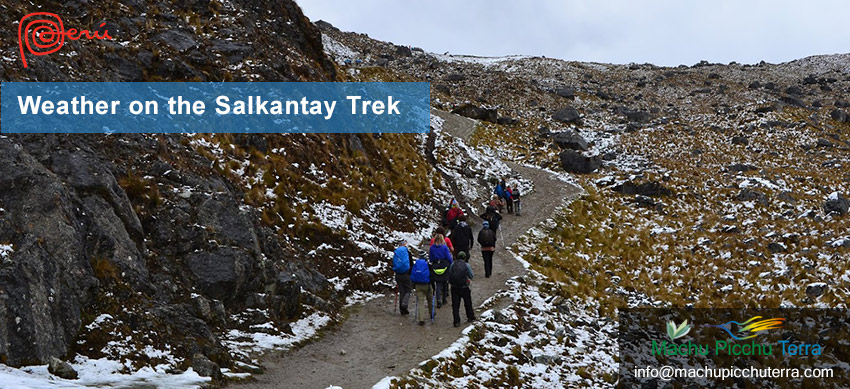
The Salkantay trek is a route that includes the journey through different geographical areas, from the high Andean mountains to the high jungle of Cusco. On the way, very different tourist attractions are visited, such as the Humantay Lagoon and Machu Picchu. In each of these places, there is a different temperature that can vary from 0 ° C. to 24 ° C. Learn in detail what the weather is like on this incredible hiking route!
The weather on the first day of the tour
- El clima en el segundo día del tour
The weather on the third day of the tour
The weather on the fourth day of the tour, the weather on the fifth day of the tour, questions and answers about the weather on the salkantay trek, how is the weather on the salkantay trek route.
The Salkantay trek is a hiking route that in its five days and 70 kilometers of the trek it crosses different altitudinal floors: from 2,040 meters of altitude to 4,600 meters of elevation.
That is, during the hiking route you feel different climates and temperatures. The maximum temperature is in the town of Aguas Calientes (24°C. on average). The minimum temperature is in the Salkantay pass (approximately 0°C).
During the walk, the average temperature oscillates between 10°C. and 16°C. The climate is temperate with cold and mild nights. The days are hot especially the first night. The rainy season is from November to March (especially in January, February, and March). The dry season (with little rain) runs from April to October.
On the first day of the Salkantay trek departs from Cusco to the town of Mollepata (2,803 masl). In the vicinity of this town begins the walk that ascends to the Soraypampa camp (3,900 masl). In the afternoon we visit the Humantay Lagoon, located at 4,200 meters above sea level. After a walk through the snowy peak, we will arrive at the town of Soraypampa where we will spend the night.
- How’s the weather? – The weather that day is temperate – cold with temperatures ranging between 14°C. and 2°C. (at night). The average temperature on the walk is 10°C. It is recommended to bring warm clothes to spend the night in.
The weather on the second day of the tour
The second day of the Salkantay trek begins at the Soraypampa camp (3,900 masl). From there, an arduous ascent is made to the Salkantay Pass, at 4,600 meters above sea level. There you have spectacular views of the snow-capped mountain as it is the closest trail to the town. Then there is a constant descent until reaching the Chaullay camp, located at 4,045 meters above sea level. There he spends the night.
- How’s the weather? – The weather that day is also temperate – cold with temperatures ranging between 15°C. and 6°C. (at night). The average temperature on the walk is 10°C. It is recommended to bring warm clothes in the morning, during the trek through the Salkantay pass, it will be possible to wear light clothes until late in the afternoon. During the night in the Chaullay camp, a jacket will be effective to combat the cold.
The third day of the Salkantay trek begins with a downhill walk from Chaullay until entering the high jungle region of Cusco as the Sahuayaco beach (2,200 masl). Then an additional walk is carried out until reaching the Lucmabamba camp (2,062 masl), tropical geography where mosquitoes abound, mountains with abundant vegetation, and beautiful landscapes.
- How’s the weather? – The weather on the third day is tropical temperate with temperatures ranging between 15°C. and 22°C. The average temperature on the walk is 18°C. That day it is advisable to bring light clothing, a hat, sunscreen, and mosquito repellent.
The fourth day of the Salkantay trek begins with an arduous walk through ascending Inca roads until arriving at the archaeological site of Llactapata (2,840 masl). Then a vertiginous descent is made to the famous Hydroelectric station (1,550 masl).
In Hidroeléctrica, after lunch and rest, the famous walk is made to the town of Aguas Calientes (2,160 masl). In this magical place you spend the night, but this time in a tourist hotel in the town.
- How’s the weather? – The weather on the fourth day of the tour is tropical – hot with temperatures ranging between 18°C. and 24°C. The average temperature on the walk is 21°C. That day it is also recommended to wear light change clothes and wear a hat because, even if it seems cloudy, the sun will still be present. Therefore, also use sunscreen and mosquito repellents.
On the fifth day of the Salkantay trek, the final hike up from the town of Aguas Calientes to the archaeological site of Machu Picchu (2,490 masl) is carried out. Optionally, tourists can buy a bus ticket and avoid the walk (approximately 2 hours).
After visiting Machu Picchu, we descend to Aguas Calientes where we board the tourist train that will take us to the city of Cusco (3,399 masl).
- How’s the weather? – The weather on the fifth day of the tour is also tropical with temperatures ranging from 16°C. up to 24°C. The average temperature on the walk is 23°C. It is recommended to bring light clothing (a light jacket), a hat, sunscreen, mosquito repellent, and, of course, your passport and entrance to Machu Picchu.
1. What is the maximum altitude on the Salkantay trek?
The Salkantay pass is the highest point of the entire adventure. This pass near the snow peak reaches an altitude of 4,600 meters above sea level.
2. What is the minimum altitude on the Salkantay tour?
The minimum altitude on the Salkantay trek tour is at the Hydroelectric station (the point where you will have lunch on day 4 of the tour). There the altitude is 1,550 meters above sea level.
3. What is the maximum temperature?
The maximum temperature on the Salkantay trek tour is on the fourth day of the tour. In the Hydroelectric station, the temperature can reach 24°C. (and a minimum temperature of approximately 17°C).
4. And what is the minimum temperature?
The minimum temperature on the Salkantay trek tour is on the first night of the tour, at the Soraypampa camp. There the temperature can drop to 0°C., or even less.
5. What clothes should I take to the Salkantay trek?
During the Salkantay trek, it is recommended to wear warm clothing for the first night and light clothing for the rest of the days. It is always advisable to bring a windbreaker jacket, a poncho in case of rain, sunglasses, a hat, leggings, shorts, cotton socks, and whatever you consider necessary.
6. When is the best weather to do the Salkantay trek?
It is recommended to do the tour from April to October. In those months it is the dry season. Therefore, there are few spots of rain, which facilitates the walk.
7. When is the worst weather to do this hiking trail?
It is believed that the rainy season is the worst time to do the Salkantay trek. However, in those months the landscapes become greener. Of course, it is recommended to bring a rain poncho and waterproof clothing. January, February, and March are the rainiest months of the year.v
8. Is it very cold on the Salkantay trek?
The cold on the Salkantay trek is intense only on the first night in the Soraypampa camp (with temperatures that can drop to 0°C.). The second day is also cold until you reach the famous Salkantay pass (with temperatures of approximately 2°C).
By Inca Trail Machu Picchu - Last updated, 13-04-2023
Interested in the Inca Trail? Know more about Salkantay Tour!
- Recommendations and safety for the Salkantay Trek
- The Salkantay snow-capped mountain at more than 6000 meters above sea level
- Salkantay trek 5 days to Machupicchu all included
- The Humantay Lagoon on the Salkantay Trek
- Tour Salkantay trek to Machupicchu 4 days
- Salkantay trek to Machupicchu route Santa Teresa 5 days
Choquequirao
- Terms and Conditions
Address: Recoleta Angosta Street # 604, Cusco - Peru E-mail: [email protected] Phones: + 51 84 207064
(+51) 982 108 083
Machupicchu Terra © 2024, All rights reserved.

Inca Trail Altitude, Difficulty and Weather
The Classic Inca Trail hike to Machu Picchu is one of the most popular hiking trails in the world. It is also one of the most difficult and challeging hikes in Peru, with an average elevation gain of 1,000 meters (3,280 feet) and a maximum elevation of 4,215 meters (13,828 feet). Hikers should book their tours far in advance and start a trainning plan to complete this hike.

The Inca Trail Altitude
Hikers often face difficulty hiking the Inca Trail altitude. At 4,215 meters (13,828 feet), its highest point can prove quite challenging - almost twice Cusco's elevation! At such height, air density drops dramatically and some may experience shortness of breath, fatigue headaches or nausea from being at such altitude.
Acclimatizing to high altitudes before embarking on the Inca Trail is key if you are unfamiliar with its height. There are various strategies you can employ in doing this, such as spending a couple days in Cusco (3,400 meters/11,200 feet), before setting out. Otherwise, take it slow on day or two of tour until your body adjusts; take breaks often during travel to help with body acclimatization and seek medical advice immediately if any symptoms of altitude sickness arise; most individuals generally experience mild side effects that disappear as time progresses whereas rare complications could arise in extreme cases.
Campsites in the Inca Trail and altitude:
- Km 82 , the beginning of the Inca Trail at 2718 m/8924 ft
- Wayllambamba , the first campsite located at 3000 m / 9842 ft
- Ayapata preferred campsite on day 1, located at 3300 m/ 10826 ft
- Lluluchapampa , the first rest stop on day 2, located at 3800 m/10829 ft
- Pacaymayo Alto , Second campsite located at 3600 m/11811 ft
- Chaquicocha , Preferred campsite on day 2, located at 3600 m/ 11811 ft
- Phuyupatamarca , the 3rd campsite, located at 3650 m/11975 ft
- Wiñaywayna , the preferred campsite on day 3, located at 2600 m/8530 ft
- Puente Ruinas , the last campsite in 5-day tours, located at 2000 m/6561 ft
Mountains in the Inca Trail:
- Dead Women's Pass , the highest point of the Inca Trail at 4215 m/13828 ft.
- Runkurakay Pass , the second highest mountain of the Inca Trail at 4000 m/13123ft
- Veronica Mountain is the highest mountain in the Vilcanota Mountain range, at 5,893 m/19,334 ft.
- Salkantay Mountain is the highest mountain in the Vilcabamba mountain range at 6,271 m /20,574 ft.
- Pumasillo Mountain , visible from Machu Picchu, at 5,991 m /19,656 ft.
- Machu Picchu Mountain , the area's highest mountain in Machu Picchu, at 3082 m/10111 ft.
- Huayna Picchu Mountain , the most beautiful mountain, at 2693 m/8835 ft.
Archaeological sites in the Inca Trail
- Salapunku , located at 2720 mt/8923 ft
- Kanabamba , located at 2625 m/8615 ft
- Wilkarakay , located at 2650 m/8694 ft
- Patallacta , located at 2614 m/8576 ft
- Wayllabamba , located at 3000 m / 9842 ft
- Runkuracay , located at 3950 m/12959 ft
- Sayacmarca , located at 3600 m/ 11811 ft
- Concharmarca , located at 3550 m/ 11646 ft
- Phuyupatamarca , located at 3650 m/11975 ft
- Intipata , located 2840 m/9317ft
- Wiñaywayna , located at 2600 m/8530 ft
- Sungate , located at 2700 m/ 8858 ft
- Machu Picchu , located at 2430 m/7972 ft
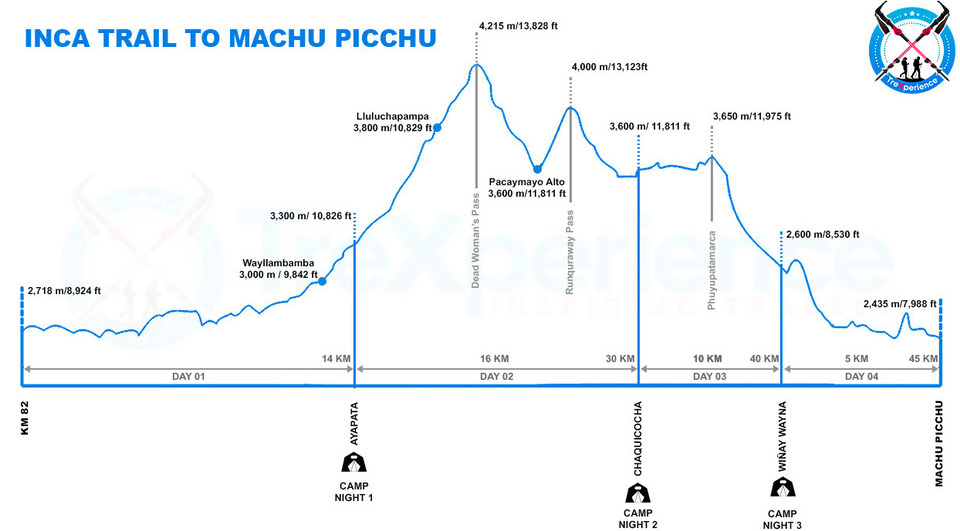
Inca Trail Difficulty
The Inca Trail is one of the toughest hikes worldwide. Stretching 26 miles (42 km), this four-day trek in Peru's Andes Mountains covers 26 miles (42 km). Reaching altitudes up to 13,828 feet (4 215m), numerous factors make its difficulty apparent.
- Altitude in the Inca Trail : Hikers can expect an average altitude on the Inca Trail of around 3000 meters/98421 feet.
- The Inca Trail can be quite steep , reaching 30% or steeper grades at times.
- Weather on the Inca Trail can be unpredictable ; temperatures can range from freezing at really hot during the day.
So if you are planning to trek the Inca Trail, it is essential that you come prepared. Here are some helpful hints and strategies on how to do just that:
- Acclimatizing in Cusco (3,399 meters/11,152 feet) prior to beginning your hike
- Once on the trail, emember to pace yourself and stop often to rest if needed.
- Stay hydrated by drinking plenty of fluids and snacking on light meals.
- Be sure to pack appropriate clothing and gear.
Inca Trail weather
The Inca Trail runs along the Andes Mountains, known for its temperate climate. However, weather can change rapidly along this high altitude trail and hiking the Inca Trail requires being prepared for all possible weather scenarios.
Sunscreen and a hat are essential during the daytime sun, while in the evening the temperature can quickly drop so it is wise to bring along a jacket for added warmth.
Nights may become cold, so it is advised to bring a good sleeping bag. Rain is likely so pack rain gear. Additionally, waterproof boots should be brought along because trails can become muddy on occasion and snowfall may occasionally occur.
Inca Trail during the Rainy Season
Cusco experiences rainy season from December to March; The Inca Trail will close during February due to maintenance and heavy rainfall. Hiking the Inca Trail during this period has both advantages and disadvantages.
- On the plus side, hiking the trail during rainfall will likely leave you mostly alone; few other people are adventurous enough to brave it!
- On the downside side, though, trails may become slippery and you are likely to get wet and cold quickly.
If you plan to hike the Inca trail during rainy weather, make sure that you bring appropriate attire - raincoats, pants and waterproof boots are essential!
Inca Trail during the Dry season
The dry season in the Inca Trailk is from May to September. While weather can usually remain more pleasant during this period, showers could still happen at any point, so ensure you pack rain gear.
The dry season is the peak season for Inca Trail hiking, booking well in advance is crucial to get the permits. Each day there are only limited spaces on the trail.
Prepare yourself for some crowds when hiking the Inca Trail - it is one of the world's most beloved trails, but during dry season can become extremely congested. If you prefer an intimate experience, choose from one of Peru's less traveled routes instead.
- Pros include reduced chances of rain and clear night skies;
- Cons include bustling Machu Picchu and Inca sites with long queues for buses and trains awaiting transport; nights may become freezing cold.
Inca Trail during the shoulder seasons.
Shoulder season is the optimal time for hiking the Inca Trail; April-May and September-October are considered shoulder seasons on this route. Weather tends to be milder during these months, making for more comfortable hikes. Though raindrops still fall, it should not be as heavy as during December-March (wet season).
What to expect when hiking the Inca Trail
The Inca Trail is known for being an epic and challeging hike, featuring steep inclines and sudden changes in altitude. Trekkers should come prepared. Deespite its dificulty, the Inca Trail can be enjoyed by most moderate and experienced hikers. Before beginning this trek, however, it's essential that all necessary preparations be made before embarking upon it;
What to do before the IncaTrail Hike?
- Prepare your body : The Inca Trail is no joke: 26 miles in length with more than 4000 steps! Hiking it over four days requires you to be in peak physical condition.
- Be Sure to Plan in Advance: For an enjoyable hiking experience, make sure you purchase comfortable hiking shoes, rain gear, a daypack, and other essentials as soon as possible to give yourself enough time for break-in before beginning.
- Book Your Spot : As one of the world's premier treks, the Inca Trail quickly fills up. If you wish to hike this magnificent trail, book early as spots often sell out quickly.
- Be Sure to Acquire Permits Early: In order to hike the Inca Trail, permits are a necessary component. Start this process early to avoid disappointment!
- Learning some basic Spanish : When traveling the Inca Trail, you may encounter people who only speak Spanish - making your trip more enjoyable if you know some basic phrases to communicate with them and help your journey go more smoothly.
What to do during the Inca Trail?
- Follow your tour guide's instructions at all times.
- Pack light but bring all essentials such as sunscreen, hats, water and snacks.
- Hike at your own pace while enjoying the scenery
- Drink plenty of water throughout the day
- Visit restrooms before beginning to hike
- Avoid venturing off-route
At Machu Picchu, you can relax and enjoy your time at one of the most iconic archaeological sites in the world.
What to do after the IncaTrail Hike?
After trekking the Inca Trail to Machu Picchu, it's essential to take some time off for rest and recovery. Here are a few suggestions of things you should do:
- Rest at least 1 day after the Inca Trail.
- Stay hydrated by drinking plenty of fluids.
- Eat healthy food which will aid recovery from hike.
- Stretch and perform light exercises to assist your muscles in recovering from your hike.
- If any soreness or pain arises from it, seek medical assistance as necessary.
After 1 or 2 days, you can explore other places like the Rainbow Mountain and Red Valley Tour .
If you would like to live the best travel experience you can consult our Inca trail tour, there you will find more detailed information about everything related to the classic Inca trail, do not hesitate to comment or contact us .
Related blogs
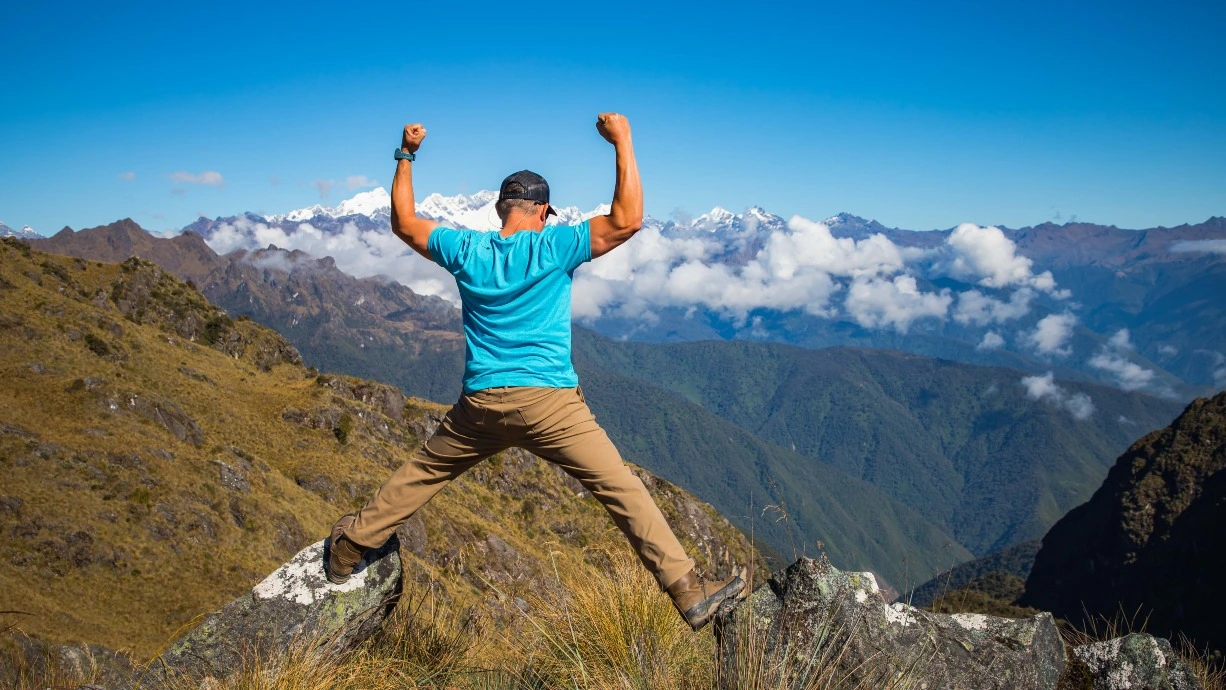
Add new comment
- No HTML tags allowed.
- Lines and paragraphs break automatically.
- Web page addresses and email addresses turn into links automatically.

Juan Coronel - Author

- Suggested treks
- Availability online
- 2 -Day Inca Trail
- Included in the trek
- Prices calculator
- 4 -Day Inca Trail
- Book for 2024
- Pre-book for 2025
- Purchase Terms
- Our authorization
- Trekker Tracker
- Our strength
- Interactive map
- Photo Album
- Multimedia Presentation
- Information Center
Annual weather and forecast
- Day/night temperatures (in ºC) Day/night temperatures (in ºF)
- Rain (in mm) Rain (in inches)
Conclusions
As you can see, there is not a perfect time (sunny, warm and dry months). You have to compromise according to your desires, if the rain bothers you more or if you are sensitive to cold.
Howerver, we can say that (from the worst to the best time of year):
- February is excluded because the Inca Trail is closed for maintenance the whole month.
- January and March are to avoid if possible because of the rain.
- April , November and December are a good compromise between an almost warm temperature and a nice weather.
- May and October offer a nice weather with fresh temperatures.
- June , July , August and September are, to us, the best time of year because the weather is very nice even if nights are cool but there is almost no rain.
Current weather and forecast for the visited sites

Inca Trail in April: Weather, Pros, Cons and more
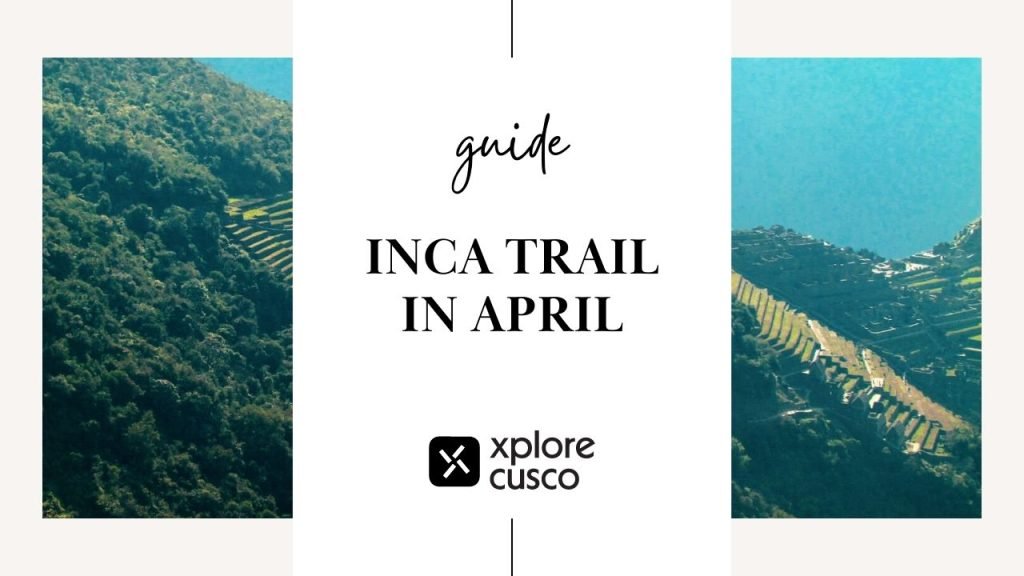
If you’re planning to hike the Inca Trail to Machu Picchu in April, you’re in for a treat. April marks the end of the rainy season and the beginning of the dry season in Peru, making it an ideal time to explore the ancient ruins. Here’s what you can expect when hiking the Inca Trail in April:
- Mild temperatures during the day and chilly nights
- Fewer crowds compared to peak season
- Lush and green scenery due to the rainy season
Is Inca Trail open in April?
Yes, the Inca Trail is open in April. However, it’s important to note that the Inca Trail is closed every year in February for maintenance. Therefore, it’s only open from March to January, including the month of April. It’s recommended to book your Inca Trail permit well in advance, as permits can sell out quickly, especially during the peak season from May to September.
Stop looking further
4 Day Inca Trail To Machu Picchu
April is one of the best months to hike the Inca Trail due to the mild temperatures and dry weather. During the day, temperatures can range from 15-20°C (59-68°F), while at night, temperatures can drop to 0-5°C (32-41°F). It’s essential to pack layers to adjust to the temperature changes.
Crowds & Costs
April is considered a shoulder season for the Inca Trail, which means there are fewer crowds compared to the peak season (June-August). However, it’s still a popular time to hike, and permits can sell out quickly. As for costs, the Inca Trail permits cost the same throughout the year.
Cons of hiking the Inca Trail in April
Although this month is a great time to hike the Inca Trail, there are some cons to consider. First, the trail can still be crowded, so it’s essential to book your permits in advance. Second, the dry season means less greenery and water sources on the trail, so it’s crucial to carry enough water.
Pros of hiking the Inca Trail in April
This month offers many advantages for hiking the Inca Trail. With fewer crowds, you’ll have more time to explore the ruins and take in the stunning views. The mild temperatures make for comfortable hiking conditions, and the dry weather means fewer mosquitoes and other insects.
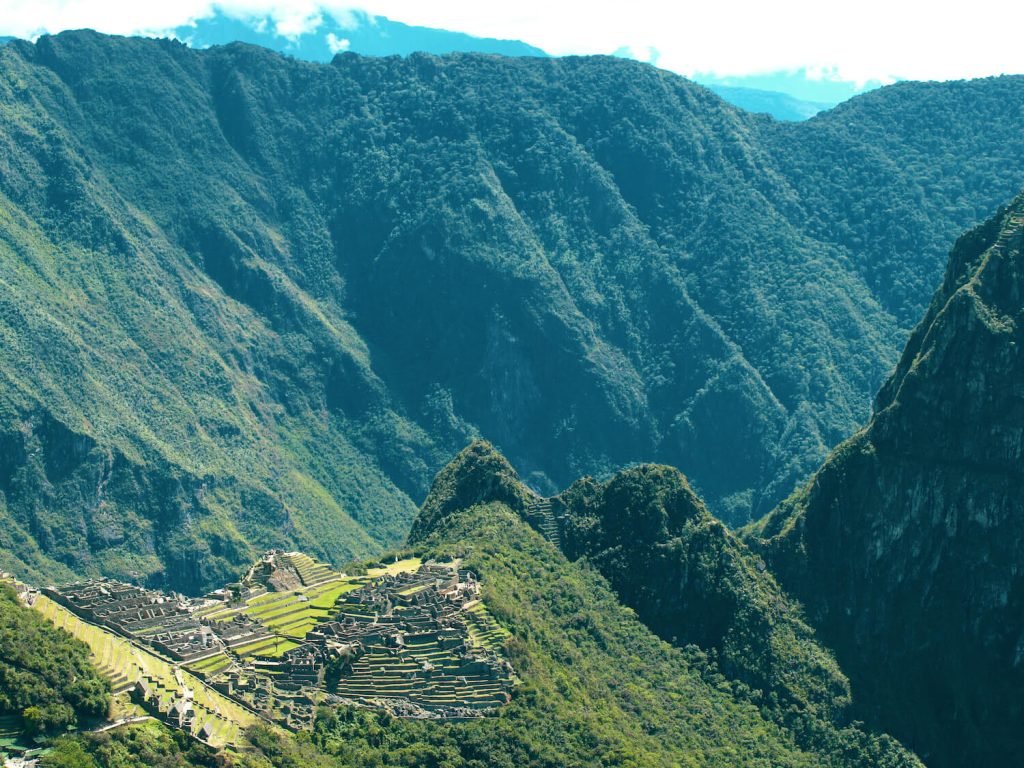
Alternative treks to Inca Trail to Machu Picchu in April
If the Inca Trail permits are sold out, or you want to avoid the crowds, there are alternative treks to Machu Picchu that you can consider:
- Salkantay Trek
- Choquequirao Trek
- Inca Jungle Trek
What to do in April in Cusco
In addition to hiking the Inca Trail, Cusco offers many other attractions to explore in April. Here are a few ideas:
- Visit the Rainbow Mountain
- Explore the Sacred Valley
- Attend the Cusco Food Festival
- Attend the Festival of the Crosses (Cruz Velacuy)
April is an excellent time to hike the Inca Trail to Machu Picchu. With mild temperatures, fewer crowds, and lush scenery, it’s an ideal time to explore the ancient ruins. However, it’s essential to book your permits in advance, as they can sell out quickly.
You should pack warm and waterproof clothing, sturdy hiking boots, a backpack, a sleeping bag, a headlamp, sunscreen, insect repellent, and a refillable water bottle.
It takes four days to hike the Inca Trail, starting from Kilometer 82 and ending at Machu Picchu. Also there are options of 2 days and 1 day.
Yes, the Inca Trail is a strenuous hike that requires good physical condition. It’s recommended to train and prepare for the hike in advance.
It’s recommended to spend a few days in Cusco or other high-altitude locations in Peru before hiking the Inca Trail to acclimate to the altitude.
Yes, there are toilets at the campsites along the Inca Trail, but they are basic and not always clean.
It’s not recommended to drink the water from streams or rivers along the Inca Trail. You should bring a water filter or water purification tablets or buy bottled water at the campsites.
Looking for other months?
Check out these articles written specifically to see what each month is like at Inca Trail.
- Inca Trail in March .
- Inca Trail in May .
Related Posts
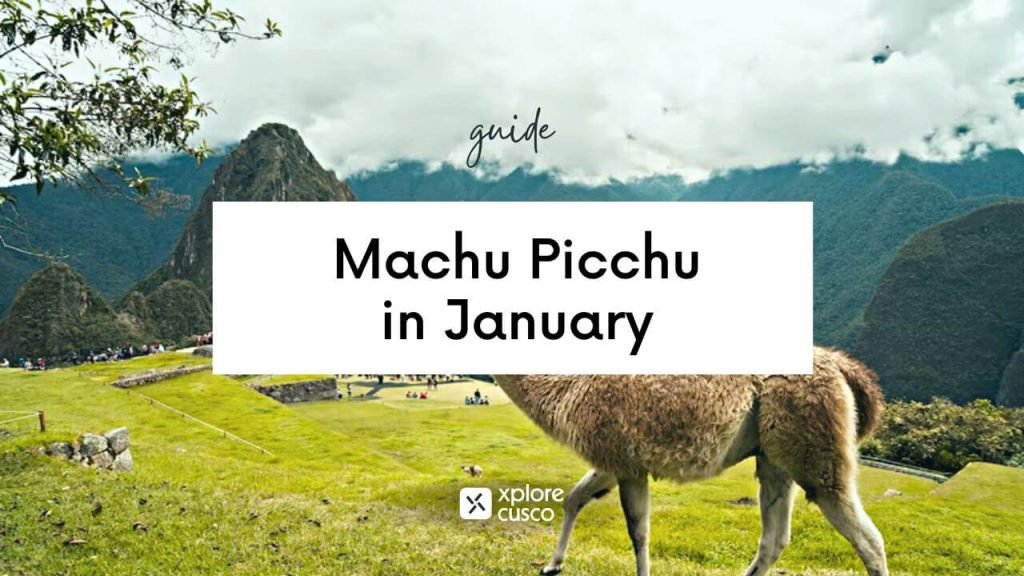
Machu Picchu in January: Weather, Tips and more
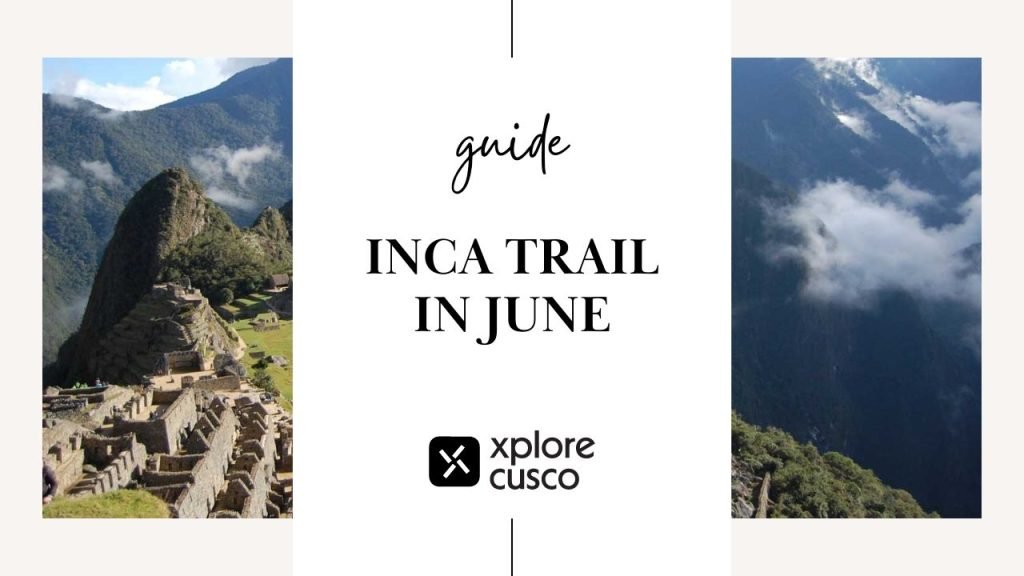
Inca Trail in June: Weather, Pros, Cons and more
Leave a comment cancel reply.
Your email address will not be published. Required fields are marked *
Save my name, email, and website in this browser for the next time I comment.
Current ye@r *
Leave this field empty
- Call Us: +51 958 191 179
- Toll Free: +1 800 916 9859
- ES +1 800 916 9859
- MX +1 800 916 9859
- UK +1 800 916 9859
- Travel Blog
- Client Reviews
- Social Projects
- Mon-Sun 9am-7pm (Peru Time PET)
- +51 958 191 179
- Enquire Now
The Essential Guide
About inca jungle weather.
The weather in Cusco can be a little unpredictable, but we’ve done our research and put together the ultimate guide to weather on the Inca Jungle Trek.
All You Need to Know About Inca Jungle Weather
Picture this: You’re having the time of your life on the Inca Jungle Trek, and everything is going perfectly. Suddenly, the skies open, and the rain comes pouring down. This isn’t what you signed up for, right?
Well, what if you knew when to expect heavy showers or clear skies and could plan your trip accordingly? You can!
The weather in Cusco can be a little unpredictable, but we’ve done our research and put together the ultimate guide to weather on the Inca Jungle Trek. Even though you might experience all four seasons in a day, we can tell you when the wet and dry seasons are and when the climate is ideal.
Read on to learn about the weather month-by-month, when the rain starts and ends, and a few other travel tips. Let’s go!
The Inca Jungle weather
Before you go, everything you need to know, what’s the best month to go to on the inca jungle trek.
The weather on the Inca Jungle Trek is relatively pleasant all year round. This is because you’re journeying through the jungle for most of it, and the climate is warm and humid. However, the first day you start at a high altitude, and it’s cold.
Our favorite months for hiking the route and enjoying the best views at Machu Picchu are May and October. They are on either side of the busy season and are just out of the main rainy season, too. You can miss the large crowds and enjoy lovely weather.
In this section, you’ll learn about the weather conditions during the wet and dry seasons and what it’s like every month to plan your vacation when the climate suits you.
Inca Jungle Rainy Season: What to Expect
In the wet season, the weather is up and down, and you never really know when it’ll start to shower. You should expect rain every day, so make sure you always carry a rain jacket or poncho in your backpack. You might get lucky, though, and get no rain. You just never know! Remember, even if it does rain, it’s often welcome in the warm jungle climate.
Throughout this season, January and February are the wettest. This means there are fewer tourists but the climate can also make the trail slippery, especially when you’re cycling downhill. You must take great care during this time of year. The advantage to traveling now is that there are plenty of discounts on hotels and tours.
Let’s check out the weather month-by-month during the wet season.
This month marks the end of the dry season, which means that the land is very dry and fields don’t look so lush. However, it also marks the beginning of the rainy season. The later it gets in November, the more likely you are to see a shower or two. The overall temperature is very pleasant, though.
This is when summer starts throughout Peru, and all the nationals start vacationing. The temperature is warm again, similar to November, but it also means that more substantial rainfall is on its way. Traveling is still pleasant during this time of year; you just need to be prepared with shielding rain gear.
You’ll find you see the sunshine a bit less on the route in January, and you’ll definitely see rain at some point most days. However, showers don’t last too long, and things usually dry quickly afterward, so you can enjoy some warm spells between the rain. The temps are still nice.
Watch out! You might get soaked in February—this is notoriously the wettest of all months in the region. You need to take extra care if you come this month, as the ground is too slippery and it’s risky. Use hiking boots with great grip. Despite the heavy showers, the temperature is still decent.
The heavy showers remain throughout March, but you’ll see a few more holes in the clouds and enjoy a little more sun. However, you’re still very prone to get wet, so having the right equipment is essential, especially hiking boots or shoes with a good grip for slippy trails.
We’re finally seeing the rainfall coming to an end this month, and the amount of precipitation drops drastically. It’s still included in the wet season because there are still drizzles here and there, but you’ll see plenty of sunshine and experience nice days in general.
Inca Jungle Dry Season: What to Expect
When the dry season arrives, most days are lovely and sunny with clear skies. You can expect some outstanding views of the landscapes and sites. However, this also means that the larger crowds are on their way with people who want to enjoy the pleasant climate.
Make sure you plan in advance during the dry season, as hotels and tours can get booked up early. You don’t want to miss out! We suggest reserving three months in advance. Let’s take a sneak peek at the months during the dry season.
The dry season starts now, officially! You might see the occasional shower but not much rain overall. The average precipitation is falling dramatically, and the temperature is enjoyable. It might start to drop at night, but it’s not too cold. This is a nice time of year to come before the big crowds arrive.
June is the driest time of the year, with extremely little rainfall. You might not see any at all while trekking this month. It’s also the beginning of the busiest tourist season, with the Cusco anniversary celebrations taking place all month. This can mean you see more people on the route and expect large crowds at all attractions.
You’ll need a warm sleeping bag this month! This is the coldest month of the year and can get chilly at night. However, you can still enjoy warm days and clear skies. Although it’s a dry month, you might see the occasional hailstorm. The sun is hot during these dry months, so be sure to use a high factor sunscreen with a hat and sunglasses.
Winter is drawing to a close this month, but you can still expect chilly temps at nighttime. Days are getting warmer, though, and you should feel very warm. Rainfall in August is still comparatively low, so it’s still a favorite time of year with tourists. Expect some great views of the unbelievable Andean landscapes.
Things are getting warmer in September, and it’s a really lovely time of year to visit. The days are hot, clear, and sunny, and you only see the odd shower here and there. It’s still somewhat busy tourism-wise.
This is the warmest month in the region and a fantastic time of year to come and beat the crowds whilst enjoying some fine weather. The skies are clear and blue with a little bit of rainfall here and there. This is the last time of the year to get remarkable views of Machu Picchu and other sites.
What Is the Average Temperature of the Inca Jungle Trek?
Well, there’s no exact average temperature as it changes with the altitude. However, you can expect it to be between 9°C and 13°C at night and 24°C and 26°C during the day. June, July, and August are the coldest months of the year.
What Is the Coldest Month On the Inca Jungle Trek?
The coldest month of the year is July. You’ll definitely feel the cold more at night, as the days are still lovely and warm.
Does the Weather On the Inca Jungle Trek Affect Flights?
Please note that you can’t fly directly to the trek. You need to come via Cusco.
Normally, flights come and go on time and without any issues. However, you need to note that if you’re coming during the wettest months, the rain is sometimes so strong that flights get delayed or even canceled. Factor this into your planning when deciding when to hike the Inca Jungle Trek.
What to Pack When Going On the Inca Jungle Trek
For the Inca Jungle Trek, you’ll need to ensure you take enough clothing and a mix of garments for the cold first morning and warmer days there on out. You can take a look at our detailed Inca Jungle Packing List for an essential guide, but here we have the items you shouldn’t leave Cusco without.
- Clothing - thin layers that you can take off and put on as the temperature changes.
- Raincoat or waterproof poncho.
- A warm jacket and sweater.
- Hand towel.
- Hiking boots or shoes - well worn-in.
- Warm pajamas.
- Sun hat, sunglasses, and sunscreen factor 50+.
- Insect repellent.
- Toiletries.
- Reusable water bottle.
- Daypack to carry all your things around in.
- High-quality camera or phone with a good camera.
- Personal medication.
- Guide book/map.
- Lock for bags.
- Flashlight.
- Adaptors for plugs (if needed).
Plan Your Inca Jungle Adventure Now
With this handy weather guide, you should understand the climate better on the route. It helps to know this info to plant your Inca Jungle Trek. Remember, the best time of year is May or October to get the lovely weather and avoid crowds.
Whenever you decide to set foot on the trail, we’re sure you’ll have the most thrill-seeking adventure of a lifetime!
Everything you need to know
Find the perfect destination in peru.
With astonishingly varied landscapes, stunning scenery, compelling history, and a legacy of fascinating cultures, there is truly something for everyone. Our expeditions in Peru are designed to showcase all that this country has to offer.
Our expeditions in Peru are designed to showcase all that this country has to offer.
Choquequirao
Rainbow mountain, travel associations & certifications.

Start a Conversation
Hi! Click one our members below to chat on WhatsApp

CUSTOMER SERVICE - CONTACT US
Our friendly local experts will respond to your request.
Please complete the form to request more information about any of our experiences. One of our travel specialists will contact you, often within two business hours, to confirm availability on the trip and provide you with other options.

INCA TRAIL IN APRIL
April is a shoulder season, for the most part, travelers will encounter fewer hikers on the trail, which makes for a more enjoyable hike; therefore, April is considered the best month to hike the Inca Trail.
The weather conditions get better. After the constant and heavy rains in the region, the clouds finally move away, and the sun comes through for illuminating the lush exuberant countrysides. Although the sun shines during the day, assume you are still going to see a little bit of rain mixed with fog, but it wouldn´t take long. At this time of the year, all vegetation along the Inca Trail has got at their bloom, and the scenery is fabulous, but when winter comes, all flowers and plants freeze and dry. If you are seeking both fewer crowds and mild weather, April is of the best month to hike the Inca trail.
Did you know that only AB Expeditions Travel Agency provides proper trekking gear to their porters? Also, they have satellite phones and a private toilet tent . Click here to book with them your Inca trail 4 days.
Things to Know
- Reservations of the Inca Trail for April are much less competitive than in June through August.
- The rainy season is over by the middle of the month.
- Orchids sprout from nearly every crevice along the Inca trail in April.
- April is still much quieter than in the peak season of June through August.
- If Holy Week falls in April, Inca trail permits run out quickly. Book your permits well in advance. Because this is the time when Peruvians and South Americans take extended vacations
- April is the best time of year on the Inca Trail for plant lovers, when the flora is at its absolute best after the rainy season, offering great views.
- This month is good for photographers who will take perfect shot, with plenty of sun and a few sweeps of cloud, and before high season crowds arrive.
- You may get light rain hiking the Inca trail in early April, but you will enjoy the magic of low-hanging clouds swirling around the green mountains.
- Rain: On average, rain falls 9 days of the month.
- Temperature: It ranges between 2.2 and 20-celsius degrees. (32 and 69 ° F).

- Perfect weather for shooting a timelapse of clouds.
- Witness some incredible Rainbow phenomenon.
- Because of the good weather, you can see some stunning scenery – mountains, glaciers, waterfalls, flowers, etc.
- April is a brilliant season for wildlife lovers.
- Tranquillity and beauty flood the Inca trail in April.
- The temperature is still warm.
- Clouds are still shading the landscape, which may shower for a moment.
Some days the Sun Gate is obscured by mist constantly so you won’t have the first glimpse of the lost city of the Incas.

Recommendations
- We recommend you book your Inca Trail in late April because in early April there is still a chance to get rain on the Trail.
- Well-made rain gear for the trek is definitely necessary.
- Bring a plastic bag for smartphones and other devices.

Do you have a rough idea of when the permits for April sell out by?
Basically, it depends on Peru’s political situation. In 2019, prior to the onset of the pandemic, permits for April were typically in high demand, often being booked three months in advance. This was because April marks the beginning of the dry season, which is the preferred time for hiking. However, in 2023, the situation has changed. Permits are running out one month in advance. This change is primarily attributed to a strike that occurred in January, leading to the temporary closure of the Inca Trail. As a result, many hikers became concerned that the strike might continue, prompting them to alter their plans and consider alternative destinations.
- On March 18th, 2024, the permits for the 4-day Inca Trail trek were completely sold out for the first week of April.
- On March 16th, 2024. the permits for the 4-day Inca Trail trek were completely sold out for the second week of April.
- On March 04th, 2024. the permits for the 4-day Inca Trail trek were completely sold out for the third week of April.
- On February 10th, 2024. the permits for the 4-day Inca Trail trek were completely sold out for the fourth week of April.
Hike inca trail with local company

- Monday through Saturday 9AM - 1PM & 3PM - 7PM
- Sunday 5 PM - 7PM
- +51976510080
- [email protected]
- Marquez Street 250, Two Blocks from the Plaza de Armas (upper floor of the market, third door on the right)
SALES TEAM HOURS
- Monday through Saturday 8AM - 1PM & 4 PM - 7 PM
- Sunday is closed
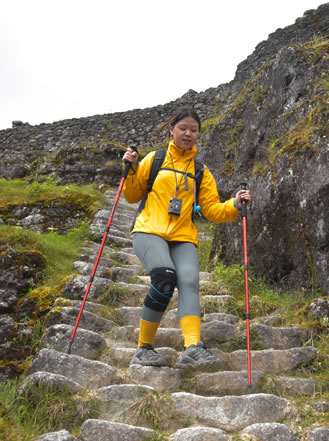
Book your Inca Trail 4 days with a Local Company with $695

IMAGES
COMMENTS
Temperatures On the Inca Trail. Temperatures in the region are fairly consistent throughout the year. Days reach into higher temperatures of 20 degrees Celsius (70-80 degrees Fahrenheit) and drop into the low digits. Campsites on mountain passes are especially cold.
The weather on the Inca Trail is very similar to that in Cusco. So, when there are heavy showers on the trek, they likely are also in the city where the airport is. Occasionally the downpours are so heavy that a flight might be delayed or even canceled.
Generally speaking, the Inca Trail weather varies along the length of the trek and can be pretty unpredictable and difficult to foresee. The Inca trail weather does not only depend on the month of the year, but it also varies as you pass through different microclimates. In other words, the Inca Trail weather can change from day to day and from ...
The best time to travel the Inca Trail is from April to October (dry season), the months of November to March, is the rainy season, which makes it difficult, the accesses and camps. The maximum temperature is 19ºC and the minimum temperature is 0ºC. The relative humidity of the air ranges between 77% in the dry season and 91% in the rainy ...
Understanding Inca Trail Weather Patterns. Inca Trail weather is a pivotal aspect of the trekking experience. The Andes Mountains influence the region's climate significantly. The trail experiences two distinct seasons: wet and dry. From November to March, it's the rainy season. The Inca Trail experiences frequent downpours during this period.
The best times of the year to enjoy the Salkantay Trek and experience the best weather are April and May or September and October. There are fewer tourists during these months, and the climate is pleasant, with minimal precipitation. However, many travelers like to plan their excursions around other events in Cusco, and June is the prime month.
Here are six bad scenarios you may run into and some tips on preparing for them. 🧠 1. Altitude Sickness on the Inca Trail. The Inca Trail has a maximum altitude of 13,828 feet, so altitude sickness is common. An estimated 50% to 85% of hikers feel some symptoms, including headache, nausea, and shortness of breath.
Inca Trail Weather along the trek to Machu Picchu. Weather can make a big difference on your Inca Trail trek. Heavy rain, freezing nights, scorching sun and hurricane force winds are possible on your trek to Machu Picchu. If you pick the right months though (see below), the days will generally be warm and dry, and the nights mostly above ...
Staying dry and cool: Strategies for managing Inca Jungle Trek Weather. The Inca Jungle Trek weaves through diverse terrains. This leads to varying and often unexpected weather conditions. Adapting to the Inca Jungle Trek weather becomes a primary concern. Humidity can be high in certain regions. Wearing moisture-wicking clothes is a good strategy.
The Inca Trail is this amazing four-day trek that follows the path of an ancient Inca highway that was built over 500 years ago. You start at this point called Kilometer 82, just outside the city of Cusco , and it takes you all the way to the Sun Gate, where you get this breathtaking view of Machu Picchu .
Inca Trail Weather "the best time to go" The Classic Inca Trail is located in the Andes mountain range, the trail goes through several types of Andean environments including cloud forest, semi-tropical valleys, and alpine tundra, all these environment types make the Inca Trail Trek's weather very diverse. During the day.
The weather in the Salkantay trek has a maximum of 24 º C and a minimum of 0° C. Too includes a visit to the Humantay Lagoon and Machupicchu in 4 o 5 days. ... The fourth day of the Salkantay trek begins with an arduous walk through ascending Inca roads until arriving at the archaeological site of Llactapata (2,840 masl). Then a vertiginous ...
Weather. June is one of the best times to hike the Inca Trail as the weather is mild and dry. The temperatures during the day range from 20-25°C (68-77°F), while at night they drop to around 5-10°C (41-50°F). The dry weather makes for clear skies and excellent views of the surrounding mountains.
The Inca Trail is one of the toughest hikes worldwide. Stretching 26 miles (42 km), this four-day trek in Peru's Andes Mountains covers 26 miles (42 km). Reaching altitudes up to 13,828 feet (4 215m), numerous factors make its difficulty apparent. Altitude in the Inca Trail: Hikers can expect an average altitude on the Inca Trail of around 3000 ...
Weather. The rainy season is over for the most part in April. Increased spells of sunshine also mean clearer skies at night, with slightly colder nighttime temperatures: wrap up warm when camping on the trail. The difference between temperature highs and lows is increasing too: highs of about 66° F (19° C) and lows of about 41° F (5° C).
Weather. It's getting brighter in the day, and cooler and crisper in the nights on the Inca Trail this month. Cusco area has highs around 66° F (19° C) and lows around 37° F (3° C). The temperature variation between average highs and average lows is 9° F (4° C) greater than it was in January, increasing the need to pack both for the hot ...
February is excluded because the Inca Trail is closed for maintenance the whole month. January and March are to avoid if possible because of the rain. April, November and December are a good compromise between an almost warm temperature and a nice weather. May and October offer a nice weather with fresh temperatures.
Weather. April is one of the best months to hike the Inca Trail due to the mild temperatures and dry weather. During the day, temperatures can range from 15-20°C (59-68°F), while at night, temperatures can drop to 0-5°C (32-41°F). ... Alternative treks to Inca Trail to Machu Picchu in April. If the Inca Trail permits are sold out, or you ...
It is the last month of decent trekking weather, but lots of visitors are aware of the advantages of this time of year and big attractions like Machu Picchu remain busy. The Inca Trail, too, will still be quite busy, albeit much less traipsed than during the last three months. ... such as the Inca Jungle Trek, which involves cycling, zip-lining ...
The weather on the Inca Jungle Trek is relatively pleasant all year round. This is because you're journeying through the jungle for most of it, and the climate is warm and humid. However, the first day you start at a high altitude, and it's cold. Our favorite months for hiking the route and enjoying the best views at Machu Picchu are May ...
Perfect weather for shooting a timelapse of clouds. Witness some incredible Rainbow phenomenon. Because of the good weather, you can see some stunning scenery - mountains, glaciers, waterfalls, flowers, etc. ... On March 16th, 2024. the permits for the 4-day Inca Trail trek were completely sold out for the second week of April.
Weather. The wet season is properly there in November in the Sacred Valley. On the Inca Trail, there is comparatively little variation between the highs around 70° F (21° C) and the lows around 43° F (6° C), it is warm by Andean standards, and temperatures do not dip below freezing even at night. While that is good news for those camping ...
Jonathan Frakes is best known for his portrayal of Commander William Riker in the TV series "Star Trek: The Next Generation" and in four Star Trek films. Frakes is a spokeperson for the ...